Mountaineer
in this issue:
Climbing to Fall in El Potrero Chico
Top Tips for Shoulder Season Backpacking

Breakups and Breakthroughs
Action Beyond Land Acknowledgment
Fall 2023 • VOLUME 117 • NO. 4 WWW.MOUNTAINEERS.ORG EXPLORE • LEARN • CONSERVE
Fall 2023 | Volume 117 | Number4
The Mountaineers enriches the community by helping people explore, conserve, learn about, and enjoy the lands and waters of the Pacific Northwest and beyond.
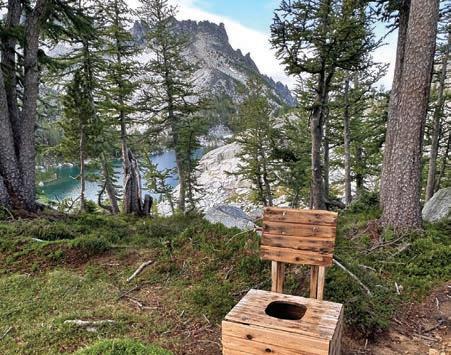
Features
20 Top Tips for Shoulder Season Backpacking

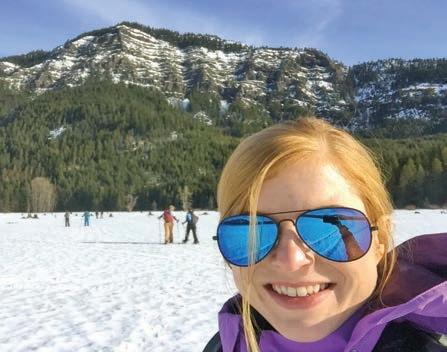
22 The Priviest Views in Washington
26 Breakups and Breakthroughs
30 Climbing to Fall in El Potrero Chico
Columns
3 Tying In
4 Editor’s Note
5 Reader Feedback
6 Member Highlight CeCe Venzon
7 Peak Performance Spice Up Your Shoulder Season Training Routine
8 Bookmarks & Staff Picks Royal Robbins
10 Youth Outside Transformative Partnerships
12 Impact Giving Transforming Loss into Legacy
14 Outside Insights
The Mountaineers Equity & Inclusion Leader Toolkit
16 Conservation Currents Walking the Walk: Action Beyond Land Acknowledgement 34 Retro Rewind
Mountaineer uses:
Discover The Mountaineers
If you are thinking of joining, or have joined and aren’t sure where to start, why not set a date to Meet The Mountaineers? Check the Branching Out section of the magazine for times and locations of informational meetings at each of our seven branches.
26 20 22
On the cover: Christine Leibbrand hiking to Gothic Basic. Photo by Andrew Lapinsky.
CLEAR
tableofcontents AREA
Naturalists
Trail Talk Forget the Day, Seize Life! 38 Global Adventures Hiking Through History 44 GoGuide How to Get Involved
Did You Know? The Fall Equinox and its Celestial Phenomena 2 mountaineer | fall 2023
of Yesterday, Today, and Tomorrow 36
46
In a stunning natural amphitheater encircled by old growth trees, our Kitsap Forest Theater kicked off its season this June with a breathtaking production of The Sound of Music.
I was one of the lucky attendees, experiencing “The Hills Are Alive” in a perfectly fitting venue. I was joined by hundreds of other guests at the first of two shows commemorating the theater's 100 year anniversary. It was an anniversary that almost didn’t happen.
A week prior to our opening show, we were locked out of backstage access by Keta Legacy Foundation. Without this access, our ability to assist guests and performers with disabilities would have been compromised and we would have lost our only safe egress for first responders in the event of a medical emergency. These concerns would have caused us to cancel this season’s performances. Fortunately, our emergency motion for a temporary restraining order was granted by the court, just days before the opening of The Sound of Music, permitting backstage access for the season.
For 100 years, the Kitsap Forest Theater has provided the community the opportunity to enjoy excellent musical productions. These productions are just one of the many ways The Mountaineers connects people with experiences in the natural world. I’ve attended shows in the past, but this summer I was particularly struck by the multiple generations of guests enjoying the show while also actively engaging with the idyllic natural setting. I was deeply grateful that we were able to proceed with productions this summer, offering thousands more people this same opportunity, especially in our centennial season.
The Mountaineers continues to defend itself in the lawsuit that Keta Legacy Foundation filed about the use of our name for fundraising and continued easement access at our Kitsap property. As I’ve shared with you before, we’re seeking a common-sense solution that’s in the best interest of our Mountaineers community. As of this writing, we anticipate a September 1 ruling on the easement issue. We plan to share another update with our community this fall when we learn more.
We’re grateful to the many Mountaineers members who have expressed words of support as we’ve been navigating these difficult issues. Seeing the joy of those attending productions at the Kitsap Forest Theater is a good reminder of the importance of our work as an organization. Helping people connect with the natural world is the core of our mission, and we look forward to the day, hopefully sooner than later, when we can put this issue behind us and focus our efforts on helping more people form deep, meaningful relationships with the outdoors.
tying in
The Mountaineers is a nonprofit organization, founded in 1906 and dedicated to the responsible enjoyment and protection of natural areas.
EDITOR
Skye Michel
CONTRIBUTING EDITORS
Kristina Ciari
DESIGNER
Sarah Kulfan, Beans n' Rice
CHIEF EXECUTIVE OFFICER
Tom Vogl
EXECUTIVE PUBLISHER
Tom Helleberg
DEVELOPMENT DIRECTOR
Bri Vanderlinden
PROOFREADER
Kate Regan
PUBLICIST
Kate Jay
BOARD OF DIRECTORS
OFFICERS
President, Gabe Aeschliman
Vice President, Manisha Powar
VP of Branches, James Henderson
VP of Governance, Roger Mellem
VP of Outdoor Centers, Matt Simerson
Secretary, Carry Porter
Treasurer, Paul Stevenson
DIRECTORS AT LARGE
Serene Chen
Rich Johnston
Brynne Koscianski
Takeo Kuraishi
Maya Magarati
Amanda Piro
Alex Pratt
Sam Sanders
Vanessa Wheeler
Anita Wilkins
Siana Wong
BRANCH DIRECTORS
Tim Schafermeyer, Bellingham
Ramki Pitchuiyer, Everett
Liz McNett Crowl, Foothills
Mark Goodro, Kitsap
Mike Kretzler, Olympia
Brad Near, Seattle
Mark Kerr, Tacoma
YOUTH BOARD REPRESENTATIVE
Katie Strausz-Clark
Tom Vogl Mountaineers CEO


The Mountaineer (ISSN 0027-2620) is published quarterly by The Mountaineers, 7700 Sand Point Way NE, Seattle, WA 98115. 206-521-6000.
Postmaster: Send address changes to Mountaineer, 7700 Sand Point Way NE, Seattle, WA 98115.
Periodicals postage paid at Seattle, WA.
Opinions expressed in articles are those of the authors and do not necessarily represent the views of The Mountaineers.
mountaineers.org 3
Tom on Mt. Rainier. Photo by Andrew Dearborn.
This past summer, I took my friend on his very first backpacking trip. As a relative newbie to backpacking myself, I was stressing about my ability to prove to him that suffering in the woods is actually worth it. I even rented him a -20 degree sleeping bag (unintentionally) because apparently my subconscious thought it best to prepare for anything, like an unexpected summer blizzard. Luckily, we were accompanied by another friend who is both a Seattle local and self-identified backpacking expert. Blasé and unconcerned, our expert friend volunteered to pack our essentials. That relieved me to assume the role of ‘encouraging the novice.’ I immediately began touting the adage that truly nothing is better than a bowl of hot ramen after a long day of hiking.
I should have known that the division of responsibilities should be reconsidered when on the drive to the trailhead Mr. Expert began snipping off the bottoms of his jeans because he didn’t own any shorts. But it wasn’t until we got to our campsite, hours and many miles of walking uphill later, that we learned said expert had forgotten to bring not only his water, but our water filter and dinner as well.
With thoughts of “gourmet ramen” behind us (in the trunk of the car, to be specific), we settled for beef jerky soaked in warm broth. I worried that we were failing our novice friend and scaring him away from backpacking for good. But he didn’t seem to mind. In fact, I’d never seen him so happy. He wasn’t wrong. That dinner was the best soggy beef jerky I’ve ever tasted.
My friend’s lighthearted enthusiasm throughout the trip was a reminder that even subpar situations can lead to enjoyable experiences. Sometimes enduring undersupplied dinners and


overheating in your sleeping bag is better than not going on the trip at all.
Inspired by experiences like these, the theme of this edition is “Seize the Day,” or at least making the most of it. We’ve got stories about how novel opportunities teach us, transform us, and sometimes even torture us. In “Climbing to Fall in El Potrero Chico,” Scott Braswell reflects on fears overcome while hanging head over heels on a cliff-face. In “Breakups and Breakthroughs,” Christine Leibbrand realizes a painful breakup as an opportunity to discover a newfound sense of empowerment in the outdoors. In “Top Tips for Shoulder Season Backpacking,” Rob Erickson offers expert tips on how to make the most of your early and late-season backpacking adventures. And in “The Priviest Views in Washington,” Kristina Ciari, backed by numerous community contributors, shows how even the crappiest activities can lead to the prettiest views. Our regular columns impart their inspiring encouragement as well. Craig Romano exhorts readers to take advantage of life’s fleeting opportunities. Guest writer Tah-Mahs Ellie Kinley offers an Indigenous perspective on how the outdoor community can engage with and honor Native lands and peoples with respect, mindfulness, and intention. Courtney Schurman provides tips on how to spice up your training routine during the shoulder season. And our Did You Know column shares ways to “seize the night” and its celestial phenomena occurring this fall. In life, and in the backcountry, some opportunities only come once. Whether you’re taking advantage of a scary opportunity, learning from a failure, swatting at flies on an alpine toilet, or convincing yourself that soggy beef jerky is your new favorite meal, make the most of it.
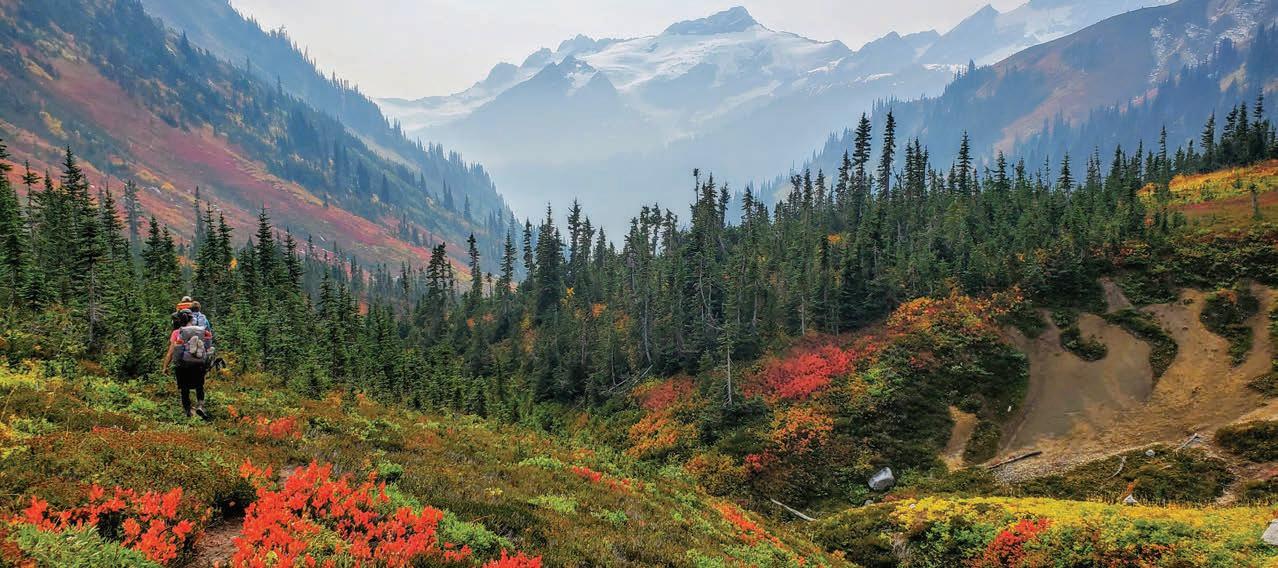 Skye Michel skyem@mountaineers.org
Photo by Eleanor Lewis.
Skye Michel skyem@mountaineers.org
Photo by Eleanor Lewis.
4 mountaineer | fall 2023 editors note
Photo by Cheryl Talbert.
In the summer 2023 edition, we shared an article on the life of Neal Kirby, a recovering alcoholic who summited Washington’s five volcanos at the age of 70. Readers wrote in with admiration, inspiration, and gratitude.
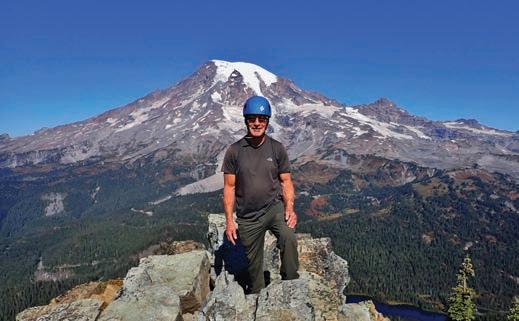
“Latest Mountaineer issue is terrific. I especially enjoyed Neal's tale. He and I worked together for a few years in the found-guilty school district. And he joined us on a summit climb I led on Adams for his first glaciated peak. I recall with pleasure the ice creams we devoured on the porch of a country store on the way home.”
-Peter Hendrickson, 18-year member
“I loved the Neal Kirby article. I am an OSAT member myself and have been sober for 2.5 years… I love a recovery story even though he has been sober for a very long time. I hope I am still as active as him at 70!”
-Anonymous Mountaineer reader, 21-year member
“Thank you Neal Kirby for sharing your story, it has given me the motivation and courage to improve my own skills. You are an inspiration to many and I’m thankful your story was toldfor all of us who relish and find ourselves in the words.”
-Regina Robinson, 8-year member
“One of my all-time favorite Mountaineers stories. Thanks Neal Kirby for your eyewitness testimonial on overcoming some of life's most difficult challenges.”
-Jim
French, 24-year member
In “How to Paint a Mountain Mural,” Kristina Ciari shared a step-by-step guide on how to bring the outdoors into your own home with an indoor mountain mural. Readers were thrilled with the tutorial and offered tips on art projects of their own.
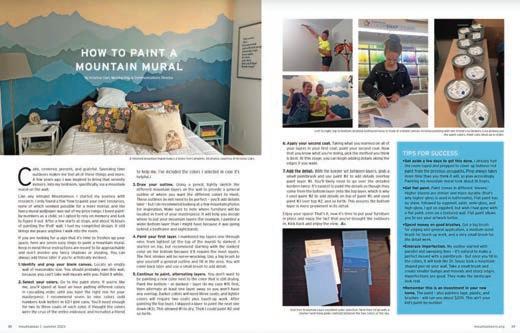
“Beautiful! Thanks for the step-by-step. I made a string art installation of Mt. Rainier, perhaps it will be cool enough to feature in a future magazine issue.”
-Megan Brewster, Mountaineer reader
“This is awesome Kristina! Thanks for sharing the process. I would too have taken an hour or many more on putting the colors in order.”
-Laurel Geisbush, 7-year member
This summer, we shared a blog on the inspiring story of Rose Vanderhoof, a 33-year Mountaineers member who became the oldest woman to summit Mt. Rainier. Readers wrote in with their congratulations.

“She’s an inspiration!”
-Visit Rainier - Official Mt. Rainier Organization, Facebook commenter
“Congratulations! Incredible accomplishment. So inspiring.”
-Susan Chan, Facebook commenter
“Absolute crusher.”
-Mike Zee, Facebook commenter
We value feedback from our readers, and we’d like to hear from you! Share your thoughts about Mountaineer magazine at magazine@mountaineers.org.
readerfeedback
mountaineers.org 5
Name CeCe Venzon
Hometown Seattle
Member Since 2012
Occupation Project Manager and WCC Board Member
Favorite Activities Mountaineering, climbing, hiking, sailing, photography
climbing and interpersonal skills. Likewise, as a Climb Leader for the rock climbing and scrambling programs, it's great to impart my love of climbing and mountaineering to other adults.
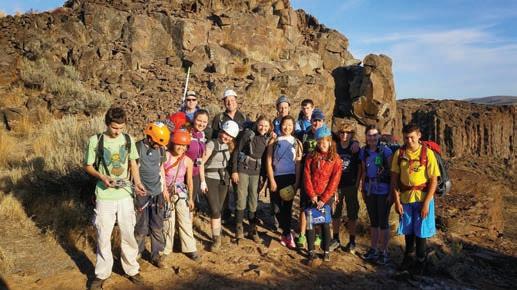
What's your favorite Mountaineers memory?
My first climb of Little Tahoma was memorable because it was my first summit. I was able to see the Northern Lights the night before our summit bid; it was amazing. I was so joyful to see first light on our summit bid and was taken aback by the grandeur of Mt. Rainier after summiting Little Tahoma. It was the first time I truly felt like a Mountaineer.
Currently, my most favorite memory was coordinating the Intro to Rock course this past May. I was so humbled and happy to share my love of climbing with others while providing them a safe space to practice. The highlight was our Vantage field trip where adult students cleaned and rappelled down their climbs. Like MAC, I was so proud of each of the students and the instructors, as I saw each of them develop and grow in their skills. Plus, we were able to enjoy such wonderful scenery and climbing with tons of jokes and laughs.

Who/What inspires you?
Conrad Anker for his kindness and groundedness.
What does adventure mean to you?
What first brought you to The Mountaineers?
Prior to The Mountaineers, I learned to rock climb. In 2011, a friend and I decided to enroll in the Basic Alpine Climbing Class, since we were versed in rock climbing. We both wanted to learn something new and different. Since then, I've taught in Seattle’s scrambling course, rock courses, and The Mountaineers Adventure Club (MAC). It's pretty cool to run into post-MAC graduates in the Seattle area and see how their lives have progressed. I'm grateful to be a part of such a wonderful climbing community where I can have a positive impact on youth and adults, including sharing the beauty of climbing and mountaineering with others because I always get a new sense of awe with each trip.
Why do
you like getting outside with us?
I love the adult and youth opportunities that The Mountaineers provides. I've been helping with MAC since 2013. It's great to have a positive impact on youth as they grow and develop their
To me, adventure means testing one's limits and exploring the unknown while keeping a sense of humor and growing as a person.
Lightning round
Sunrise or Sunset? Sunset
We all know about the Ten Essentials. What's your 11th essential? Pocket journal and pen
What’s your happy place? Any summit
Post-adventure meal of choice? Taco Time or Kidd Valley
If you could be a rockstar at any outdoor activity overnight, what would it be? Ultra hiking through Norway while seeing the Northern Lights
CeCe instructing at Vantage for the Intro to Rock course. All photos courtesy of CeCe Venzon.
MAC climbing trip at Vantage, 2013.
6 mountaineer | fall 2023 member highlight
Spice Up Your Shoulder Season Training Routine
By Courtenay Schurman, MS, CSCS, PN2
Now is the perfect time to beef up your fitness regimen to take advantage of unique seasonal opportunities. Take that exercise class you’ve never had time for or explore a new form of exercise. How about a backpacking trip or a rainy hike? The trails beckon you to enjoy the changing colors, cooler temperatures, and solitude. Pick one or more of these strategies to spice up your exercise routine and stay ready for anything this shoulder season.
Aerobic fitness
Maintain the conditioning you built over the summer by hiking at least once a month, year round. Then, rebuilding your aerobic fitness in the spring will feel so much easier. The cooler weather means you’ll need to carry extra weight such as clothing, a thermos, and a stove. With snowshoeing and cross-country skiing right around the corner, both of which require aerobic fitness comparable to hiking, take advantage of shoulder season hikes to stay ready for winter activities.

Cross-train
If you are a multi-season sports enthusiast, fall is pre-season for snow sports. Downhill skiing requires additional strength in the quadriceps compared to hiking, while backcountry skiing can require as much elevation gain and loss. Determine what your winter plans are and start shoring up any weaknesses. If your legs need a break from downhill travel, add a day of biking to your program to target the quadriceps in a new way. By including cross-training, or combining different exercise activities in your program, you decrease your risk of injury from repetitive strain or overuse.
Strength
Shoulder season is the perfect time to strengthen muscles that were de-emphasized. In-season hiking requires strength in the legs, core, and back. Add pushing movements (such as pushups, overhead presses, or triceps bench dips) now to keep your body in balance and prevent injuries. You can also carry a
light backpack while running errands or walking to maintain the strength in your core and calves, and add strengthening moves for the abductors and adductors (lateral hip muscles) to allow you to comfortably side-step, twist, and rotate the hips.
Variety
Speaking of hip rotation, participate in dance classes or racquet sports (such as tennis, racquetball, squash, or pickleball) to keep your lateral hip muscles engaged and functioning properly. Variety in movement helps improve coordination and agility, engaging your brain differently so you’re less likely to burn out and more likely to stick with your exercise program. If ball sports aren’t for you but you enjoy the social aspect of hiking, consider trying an exercise class like yoga or Tai Chi to work on mobility and flexibility, with the added benefits of mindfulness built in.
Develop psychological skills
The mind is a powerful tool that also needs to be exercised and trained. If you’re preparing to try something outside your comfort zone, practice tackling your fears with visualization and Box Breathing. Visualization is a practice that allows you to rehearse how you might confront various obstacles. It treats imagined scenarios the same as real and gives your mind practice dealing with struggle. Box Breathing is a form of breathing that helps calm the vagal nerve, which is responsible for our “fight-or-flight” response. To do it, inhale fully to the count of four, hold your breath for four counts, exhale completely to the count of four, and hold out for four counts. Repeat four times. Control over your breathing and thoughts are powerful tools you can access anytime with practice.
Courtenay Schurman is an NSCA-CSCS certified personal trainer, Precision Nutrition Level 2 Certified Nutrition Supercoach, and co-owner of Body Results. She specializes in training outdoor athletes. For more how-to exercises or health and wellness tips, visit her website at www.bodyresults.com or send a question to court@bodyresults.com.
mountaineers.org 7 peak performance
Photo by Ryan Rodman.
Royal Robbins
The American Climber
From essentially inventing modern Yosemite big wall climbing in the 1960s to pioneering a philosophy of climbing and conservation that continues to reverberate today, Royal Robbins is a legend by any measure. Now for the first time, award-winning author David Smart illuminates the full story of the man who the New York Times deemed the “conscience of rock climbers” — in all its soulful ambition, rivalry, and romance. Published by Mountaineers Books, Royal Robbins: The American Climber is the definitive biography of one of history’s most influential climbers, from a hardscrabble youth to the heights of Yosemite and beyond.
David is the founding editor of Gripped magazine. His biography of Austrian solo climber Paul Preuss was shortlisted for the Boardman Tasker Prize, and his biography of Italian climber Emilio Comici won that prize along with the Banff Award for Climbing Literature. Read on as David discusses his inspiration for this book, his takeaways about Royal Robbins, and more.
This interview originally appeared on Gripped.com.
Who was Royal Robbins?

He was the leader of climbing in Yosemite in the 1960s, beginning with the first ascent of Half Dome in 1957 with Jerry Gallwas and Mike Sherrick. He invented American big wall climbing with the first continuous ascent of the Nose, the first ascents of the Salathé and North America Walls, with his frequent partners, Yvon Chouinard, Joe Fitschen, Chuck Pratt and others. He helped invent the modern grading YDS system, pushed hard in free climbing, made some of the first north American rock climbing road trips, was one of the first American climbers to garner a reputation internationally, introduced clean climbing to America, and pioneered the outdoor industry. He was also an intellectual, a prolific writer and a man with serious convictions, bred partly from growing up poor.
What was it about Royal that made him become such a legend?
He would be one of the most important figures in climbing just for turning Yosemite, a backwater in climbing in the 1950s, into the world center of rock climbing. But he was also a communicator, a writer, who published his convictions, his achievements, and his foibles. He influenced the whole climbing scene. He was also an enigmatic personality, constantly on stage due to his preeminence. At times he could come across as arrogant or eccentric, but he was also deeply committed to his circle and the wider community. People wanted him to like them.
How did he inspire a generation of climbers?
Ethics. The notion that there ought to be rules to the game. His life showed how complicated a proposition that is, but the vision, the struggle with the ideals, remained. On a personal level, he mentored and learned from the young
Royal Robbins belaying on reconnaissance for the first ascent of the North America Wall in Yosemite in 1964.
Photo by Glen Denny.
An interview with author David Smart
8 mountaineer | fall 2023 bookmarks
climbers, who in turn, tried to match and improve upon his record. In a way, however, they never did routes that exceeded the significance of his climbs.
What motivated you to write a book about him?
I’d written about European climbers Paul Preuss and Emilio Comici, who also had high ideals, were fascinating, complicated, human individuals, and led the world climbing scene. Robbins seemed to naturally come next, as he shifted the whole focus and cultural center of climbing from Europe to America. There was a lack of a modern biography of Robbins. The family, and particularly Tamara and Liz Robbins, his daughter and widow, respectively, as well as many of his friends, encouraged me and provided unpublished letters and papers that shone fresh light on Robbins. After I interviewed Glen Denny, a climbing partner of Royal’s, he passed away. Malian writer Hampate Ba wrote that a “dying man is a burning library.” It seemed an opportune time to collect all of these stories. Towering figures in their fields, like Robbins, or for that matter Beethoven or Van Gogh in their fields, challenge every generation to come to terms with what they mean for the tradition. This is my contribution to that understanding.
Will the readers be shocked by anything that wasn’t previously public knowledge?
Shock is a pretty subjective response. As a biographer, not much shocks me. The book has new (to most readers and me, anyway) insights into what made Royal who he was. There’s a lot of unpublished material he wrote about famous incidents like the removal of the bolts from Dawn Wall, and his struggles with being a climber before there was much societal support for it. His personality and its roots and expressions are explored as well as I could. His relationship with Warren Harding was definitely more nuanced and friendly than most people think it was. Camp 4 was a pretty wild place in the 1960s, in the best sense, as far as I’m concerned, but the reader can come to their own conclusions.
Read the full interview at Gripped.com. Royal Robbins: The American Climber is available for purchase at our Seattle Program Center bookstore, online at mountaineersbooks.org, and everywhere books are sold.

Return of the Bison: A Story of Survival, Restoration, and a Wilder World
 By Roger L. Di Silvestro
By Roger L. Di Silvestro
Return of the Bison delves into the remarkable journey of the American West's iconic symbol, nearly lost to time but restored against all odds. Journalist Roger Di Silvestro masterfully unravels the intricate history behind the bison's near-extinction and the subsequent revival efforts. With a blend of enthralling natural history and accounts of influential figures like Teddy Roosevelt and George Bird Grinnell, Di Silvestro paints a vivid picture of the relentless struggle to save these magnificent creatures. Amidst discouraging setbacks, the narrative highlights the crucial involvement of America's Indigenous peoples, whose intertwined fate with the bison breathes new life into both their cultural heritage and the species' triumphant return. Return of the Bison is a testament to the resilience of nature and the power of collective conservation efforts, leaving readers deeply inspired.
Knowing the Trees: Discover the Forest from Seed to Snag
By Ken Keffer, illustrated by Emily Walker
In Knowing the Trees, naturalist and outdoor educator Ken Keffer explores our forests with precision and charm. Following the life cycle of a tree, this gorgeously illustrated guide showcases the natural wonders of a forest: seed dispersal, vast underground networks of interconnected roots, inner workings of tree trunks, photosynthesis in the treetop canopy, ecological contributions of snags and nurse logs, connections between species throughout the habitat, and more. From the coastal temperate rainforests of the Pacific Northwest to the iconic fall foliage found in New England to the dry chaparral plateaus of the Southwest, experience a world of woodland wonder – a perfect gift for the tree-lovers in your life.

A Climber’s Guide to the Teton Range, 4th Edition
 By Renny Jackson and Leigh Ortenburger
By Renny Jackson and Leigh Ortenburger
Years in the making, the new edition of this essential guide includes 932 routes on more than 235 peaks and canyon walls throughout the Teton Range. For each route, longtime Teton climbing ranger Renny Jackson supplies difficulty classification, first ascent information, and access to the route, and, as needed, approach considerations, route and/or pitch details, and route of descent. In addition to dozens of new routes and a new chapter on the Grand Traverse, readers will find a greatly expanded section on the history of climbing in the Tetons along with updated information about geology, climatology, preparation, regulations, and ethics.
staff picks
mountaineers.org 9
Each year, our Mountain Workshop program gets over 1,000 young people outside. Mountain Workshops are single or multi-day experiences designed in partnership with other youth-serving organizations. They are collaboratively designed to create memorable and accessible outdoor recreation experiences for youth while meeting the needs and goals of their respective communities.
One of our longtime partners is Interagency Academy — a network of small, alternative high schools throughout the greater Seattle area. They have been running programs with The Mountaineers for over a decade, and this Mountain Workshop series is often a school-year highlight for students and teachers, as well as our Mountaineers volunteers and youth programs staff.
A collaborative partnership

Interagency Academy provides unique and personalized learning environments to students who are unable to receive the support they need in mainstream high school. The associated schools are designed to provide support of all kinds to their students, and to do so, many schools will collaborate with local community-based organizations – like The Mountaineers – to offer safe learning environments.
“The students we work with are generally attending [Interagency Academy] due to either having been suspended, expelled, or dropping out of mainstream high school,” said Laura Levings, a mental health counselor and challenge course facilitator who works with Interagency students. “We find that our students have difficulty connecting and engaging
Transformative Partnerships
Empowering Interagency Academy Students Through Mountain Workshops
By Ethan Metzger, former Associate Programs Manager
with other students. There is a lack of trust with schools, staff, and others in their lives. Many of our students are isolated and don't have a big support system, and many have a background of trauma, abuse, neglect, and low self-esteem.”
Mountain Workshop programs with The Mountaineers provide a thoughtful, safe, and collaborative educational environment that fosters a sense of unity and connection among the Interagency students, positively impacting their overall educational experience.
Learning to climb with The Mountaineers
After a two-year hiatus during the pandemic, we were excited to reengage with the students at Interagency Academy for the 2022-2023 school year. Our first meetings took place in January, when we participated in team building activities with the students, facilitated by Interagency staff. We also worked intentionally to establish community agreements that would guide the rest of our time together.
After getting to know one another, we jumped straight into climbing at our Seattle Program Center. For the majority of the students, this was their first exposure to anything climbingrelated, and once they started climbing, they opened up and got curious. We talked about ropes, and physics, and friction. They asked a lot of safety questions, and we talked through what will happen and why the system is safe. Answering these questions built trust, and it gave the students an opportunity to challenge themselves and try something new in a supported environment. It showed the students that they could do hard things and rely on their community for support.
10 mountaineer | fall 2023 youthoutside
Interagency students learning to belay at the Seattle Program Center. All photos courtesy of Mountaineers staff.
From January to June, Interagency students participated in three climbing sessions with The Mountaineers, learning climbing skills, trying new activities, and building connection with one another. Students also spent three sessions at Camp Long in West Seattle, where they participated in a challenge course progression with team building initiatives and a low and high ropes course. All of this helped students foster a deeper sense of confidence, community, and belonging.
After six sessions, students were given the choice to spend an extra day at the challenge course or try outdoor climbing at Exit 38. The students who opted for outdoor climbing had the opportunity to test their climbing skills in a new environment.
A day at Exit 38
After six months of climbing at the Seattle Program Center, students were eager to showcase the skills they had acquired and practice climbing, belaying, and rappelling outside. We equipped the group with harnesses and helmets and began the short approach to the walls.

Once there, students encountered 50 vertical feet of rock ready for climbing. Laura Levings explained that the rock serves as a metaphorical “wall” for other challenges that students face in their lives, and students have both the skill and support to tackle those challenges.
In the ensuing hours, students courageously ventured beyond their comfort zones, scaling rocks and walls both physical and metaphorical. For many of the students, this marked their first experience climbing on real rock. And while not all students choose to climb that day, an atmosphere of laughter and smiles permeated the area. Students were supported to challenge themselves, and they had learned to trust both themselves and their community. According to one teacher, this outdoor excursion fostered a sense of relaxation that they hadn’t witnessed in quite some time.
Insights and impact
Several weeks after climbing at Exit 38, I had the opportunity to connect with Interagency staff and gain valuable feedback on their experience partnering with The Mountaineers and the Mountain Workshop program.

One staff member highlighted the effectiveness of the joint effort to create a positive experience for students, saying
the collaboration between the schools, The Mountaineers, and the challenge course had created a highly successful and engaging learning environment for their students. Another expressed how these programs had helped students become aware of the importance of support systems for their personal growth and development. "We debrief around fears, support, and what they need to be able to get to the next best place in their lives,” they said. “Many of the students start to realize that they do need support, whether it's the belayer or others giving encouragement, to be able to get to the next best place in their lives."
The collaboration between Interagency and The Mountaineers not only offers a unique outdoor experience, but contributes to the students' academic journey. “Students get PE credits in school for coming on this program, which they all need and helps them to attain their credit requirements,” staff said. “I had a teacher tell me a few weeks ago that due to this program, she and all the other teachers at their site saw all the students connect, support, and work together for the very first time. There is absolutely no doubt that this program has huge benefits for our students in a variety of ways."
Our partnership with the Interagency Academy perfectly illustrates the impact we hope to have through our Mountain Workshop programs. The journey we embarked upon together to build connection through climbing was transformative for all involved. We are grateful for our partnership with the Interagency Academy and we look forward to getting back on the rock in 2024.
Interagency students learning to tie in.
mountaineers.org 11
Interagency students enjoying a day of rock climbing at Exit 38.
Transforming Loss into Legacy Remembering Ian Cox Through Mountaineers Scholarships
By Brianne Vanderlinden, Director of Development
We all move through the stages of grief at different speeds, and never in the same order. Sadness tends to hit me first, followed by denial and anger. With self-care and some extra time on the trail, acceptance comes into view. In my role at The Mountaineers, I’m often the first person people talk to when sharing the news that a Mountaineers member has passed, and these conversations never get easier. On the bright side, something that is very special about this community is how fast motivation and inspiration presents itself. The spirit of adventure is forever present, even when facing serious loss.
One of my most inspiring memories from the last six years was receiving a call about Mountaineers Member, Ian Cox. As Mountaineers, we had heard Ian’s name circling among search and rescue volunteers. Ian’s close friend, Brian Bickel, was the one who stepped in to make the difficult call and discuss honoring Ian’s memory.

As Brian described, “Ian was everyone's gateway to the great outdoors, a confident and skilled partner on any adventure, an amazingly kind and cheerful friend, and just a great time. He was the first person to suggest hitting the trails on a trek he most assuredly was sandbagging you on, only to then be the one to help you overcome your perceived limits and grow. That pattern of challenging those he loved, guiding the way, and ensuring steady growth is something that permeated every relationship in his life, to often hilarious ends. Hidden behind a knowing smirk radiated an unspoken self-assuredness you
could feel and rely upon. I'll never forget the call on a very unfortunate day in my life where I asked for his help burning off some energy, which Ian somehow interpreted to mean a 29-mile trail run with a few rock scrambles. I definitely didn't believe I was ready for that when he explained our route at the trailhead… until we finished it. He also famously told a friend of ours as she pondered if she could finish climbing a mountain 'I'm not going to let you give up the first time you say you quit.’”
Ian and his twin brother, Connor, started their Mountaineers membership in utero. Their parents, Duncan and Marla Cox, met in the Basic Climbing Class in the early 90s and have continued to volunteer, supporting new students through the Sea Kayaking course. Ian caught the climbing bug from his parents and pursued summits as his main passion in life. He climbed all the major volcanoes in Washington and recorded over 196 ascents.
On an unfortunate day, August 20, 2022, Ian went on a solo trek through the Cascades and didn't return. He was alone on Mt. Degenhardt, on a technical traverse. When he missed a climbing rendezvous and his satellite phone wasn’t triggered, his family knew something was seriously wrong. Even after an exhaustive search and rescue effort, the search for Ian was unsuccessful. The prevailing theory of what happened was that due to receding glaciers, the transition between ice and rock was weakened. As he stepped off the glacier onto rock, the ice gave way, causing him to fall.
impactgiving
Photo by Asa Sourdiffe.
12 mountaineer | fall 2023
In the days and weeks following, Ian’s friends and family came together to imagine how they could honor Ian’s life. As they struggled to cope with the loss and all the feelings that came with it, they found an inspired motivation to turn their grief into something positive and launched the first annual Ian Cox Memorial Dicks-A-Thon, a brilliant and hilarious feat of physical, mental, and gastrointestinal strength — a true testament to Ian’s humor and character.
Ian Cox Memorial Dicks-A-Thon
It will not be easy for me to explain all that this athletic event entails. As Ian’s friends and family have enthusiastically described, The Dick’s-A-Thon is a circumnavigation of Seattle Dick’s Drive Ins, totaling 26 miles. The caveat is that along the way, you have to eat the entire Dick’s menu. Connor Cox encouragingly warns that “You will stumble, you will stagger, you will cramp. Just like Ian would have wanted.”

If 26 miles and five eating events feels ambitious, you have options. You can join the shorter 14.6 miles and enjoy a limited menu, or the 7.6 mile Victory Lap. If you love food but hate running, you can even support virtually with an eatingonly option.


Connor, is the best person to tell the origin story — though you’ll have to subscribe to our digital blog to hear it later this month. No matter what level of challenge you lean into, all proceeds of the event will be donated to The Mountaineers Access Program (MAP), Washington National Parks Fund, and five Washington search and rescue organizations: Snohomish County SAR, King County SAR, Seattle Mountain Rescue, Washington State SAR Planning Unit, and Whatcom County SAR. Together, these organizations continue Ian’s legacy of getting people outdoors and giving back to the search and rescue organizations that gave so much to Ian’s loved ones. In the first year, over 100 people joined the event to celebrate Ian and raised a miraculous $32,000. In addition to the heroic volunteers carrying on Ian’s legacy, a number of organizations

rallied together to support the event. The Pacific Northwest post-hike staple, Dick’s Drive In, served over 500 menu items to fuel participants, and continues that great tradition this year as a key partner. And Ian’s employer, LifeStance Health, donated over $15,000 to match peer donations to the event. Those funds directly benefited MAP, providing need-based scholarships that reduce financial barriers for those seeking adventure and belonging through The Mountaineers.
Ian’s legacy lives on through scholarships
Although eating while running isn’t exactly my favorite way to spend calories, I’m so excited to witness the magic of this event and see it bring meaning to Ian’s legacy. In Fiscal Year 2022, contributions to MAP, such as the gift LifeStance offered in Ian’s memory, provided over $55,000 in scholarships, empowering 253 youth and adults through membership, activities, courses, and more. This year, the proceeds received through the Dicks-A-Thon will continue to support scholarships and help us kick off #GivingTuesday efforts this fall, allowing us to provide more people with positive introductions to the outdoors, regardless of their financial means.
Those closest to Ian have transformed their experience of great loss to celebrate Ian Cox and the impact he had on their lives. By starting a brand new 501(c)(3), they are working together toward a vision to share Ian’s legacy with the greater Seattle community by getting people out of their comfort zones and into unforgettable adventures. The Mountaineers is proud to sponsor the second annual Dicks-A-Thon, taking place on October 21, 2023 and kicking off from our Program Center in Seattle’s Magnuson Park. Registration is officially open and we hope you'll honor Ian's memory and appetite for challenge by joining us.
Support scholarships at The Mountaineers and sign up to participate or volunteer for the Ian Cox Memorial Dicks-A-Thon at www.dicksathon.com.

mountaineers.org 13
Photo by George Bickel.
Photo by Asa Sourdiffe.
Photo by George Bickel.
Photo by Patrick Lacey.
Photo by George Bickel.
The Mountaineers Equity & Inclusion
Leader
Toolkit
Fostering Belonging in the Outdoors
 By Michelle Song, Volunteer Development Manager
By Michelle Song, Volunteer Development Manager
The outdoors has always been a source of inspiration and rejuvenation. It presents an opportunity to forge deep connections with nature, push our boundaries, and craft lasting memories. At The Mountaineers, we believe all people should have equitable access to the outdoors and the transformative benefits it provides. Through our volunteer-led programs, we strive to empower our members and foster a culture of belonging by providing outdoor skills education to individuals from all backgrounds.
Supporting our organization's leaders is essential to promoting an inclusive outdoors and offering outdoor education that feels accessible for people of all backgrounds and abilities. Each year, thousands of dedicated volunteers lead every aspect of our organization. They embody the spirit of giving back, devoting their time and expertise to support committees, organize trips, teach courses, and manage important behind-the-scenes tasks year after year. Motivated by the growing requests from our volunteers for guidance in creating inclusive spaces during their activities, a working group of Mountaineers volunteer leaders from across branches and activities created The Mountaineers Equity & Inclusion Leader Toolkit.
Developed with support from The Mountaineers Equity & Inclusion Committee, the E&I Leader Toolkit is a rich collection of reading materials, resources, and reflective exercises. The toolkit is one component of The Mountaineers broader strategy to foster equity and belonging within the organization, complementing other efforts such as changing staff hiring processes, updating board policies, improving the scholarships program, and more. The toolkit is not a comprehensive lesson plan on diversity, equity, and inclusion, but rather a carefully curated list of tools and ideas that volunteers can use to create
more equitable and inclusive activities. Siana Wong, past Chair of the Equity & Inclusion Committee and one of the creators of the toolkit, explains, “It was built by Mountaineers volunteers for Mountaineers volunteers... Many of the resources and examples are directly what volunteers have asked for, based on volunteers’ and members’ past experiences or what they might encounter in the future. There are specific tools to help leaders plan, execute, and finish their activities with an equity and inclusion perspective.”
Impact and evolution
Designed specifically with a Mountaineers volunteer in mind, the toolkit encourages volunteer leaders to consider fostering feelings of belonging at every step of the planning and implementation process. Volunteers are emboldened to infuse their activities with these principles, all without altering their activity’s core goals.
Siana is especially enthusiastic about the toolkit's comprehensive scope, highlighting it as a tool for volunteers serving in any capacity. “There is a great deal of information covering inclusive leadership, managing group dynamics, and addressing conflict and bystander intervention,” she says. “These kinds of topics span across activities, committees, and branches.” Siana and fellow toolkit creators aspire for it to become a common resource for all our leaders.
Mountaineers volunteers have the opportunity to bring about transformative experiences in nature, and the Equity & Inclusion Leader Toolkit helps facilitate those experiences. “The more leaders become educated in equity and inclusion, living it by example and helping to spread this work, the better we are able to cultivate equity and belonging in our Mountaineers community,” said Siana. When we equip our
outsideinsights 14 mountaineer | fall 2023
Cape Alava, Olympic National Park. Photo by Nate Derrick.
volunteers with the knowledge and tools to embrace equity and inclusion, they become catalysts toward a rich culture of belonging within The Mountaineers.
Recognizing the dynamic nature of our organization and the evolving needs of our community, the toolkit was intentionally designed to be adaptable – a living resource that will evolve and grow in step with our organization's progression. “The toolkit is also meant to be organic, so I hope that just as our organization must adapt and change to the needs of our community, so will the toolkit,” said Siana.
In the spirit of shared learning and improvement, volunteers are encouraged to contribute their experiences, insights, and success stories to the toolkit. This collaborative approach allows for an ongoing exchange of knowledge, ensuring that the toolkit remains relevant and effective to the audience it serves.
Future vision
The Mountaineers Equity & Inclusion Leader Toolkit serves as a valuable resource, inspiring volunteers to approach their trips and courses from an equity and belonging perspective. As an example, volunteers have the ability to decide what information to put into a trip listing. The Toolkit outlines different items that should be included to best manage expectations of participants both before and during the activity. What is the goal of the trip? What's the anticipated pace? How does the leader like to make decisions and manage group dynamics? Spelling out this information helps potential participants understand what is expected of them and determine whether or not that trip is a good fit. All of this fosters a healthy group dynamic before a trip that can be further strengthened through in-person activities. All of us do better when we know what is expected of us and what to expect from an experience. By providing everyone with the same information, we can level the playing field to make our activities more accessible and help foster a feeling of belonging for everyone.
While the toolkit is primarily designed for Mountaineers volunteers, its usefulness extends to anyone seeking insights

and tools in the pursuit of equity and inclusion. The ultimate intention of the toolkit is clear: the more Mountaineers who engage with the toolkit and integrate it into their programs, the greater positive impact we can have on fostering a community where everyone feels safe in the outdoors.
Access The Mountaineers Equity & Inclusion Leader Toolkit at mountaineers.org/equity-inclusion-leader-toolkit. Want even more resources on fostering experiences with equity and belonging? Check out our Emotional Safety in the Outdoors eLearning course at mountaineers.org/emotional-safety-in-the-outdoors.
A message of gratitude from Siana:
“A large thank you goes to the small group of dedicated volunteers that spent a lot of time discussing and brainstorming during meetings, attending membership-wide listening sessions related to equity and inclusion, researching relevant subject matter, collecting resources, and creating content in order to build the toolkit. Although not the most glamorous of work, these contributions are so important to helping us achieve our goals of cultivating equity and belonging.”
Key Features of The Mountaineers Equity & Inclusion
Leader Toolkit:
Trip and Course Planning: The toolkit provides practical guidance on how to create inclusive experiences for participants of diverse backgrounds and abilities. It offers insights into trip logistics, communication templates, and post-activity considerations for adapting activities to accommodate varying needs.
Language and Communication: Recognizing the power of language, the toolkit provides guidance on incorporating inclusive terminology during an activity or course, such as including time to share pronouns during introductions. It highlights the importance of mindful communication to ensure an equitable experience for all participants.
Recruitment: The toolkit offers ways of engaging with aspiring volunteers to ensure the continuity of our programs. It provides ideas for outreach and developing mentoring opportunities to support continued participation across our activities.
Resource Library: The toolkit includes an extensive collection of resources, readings, and reflection prompts, including sample forms, templates, checklists, and more. Leaders can leverage the content to enhance their own skills facilitating inclusive experiences, growing cultural competence, understanding unconscious biases, and promoting constructive conversations.
mountaineers.org 15
Siana and her husband, Marko Pavela, at the top of Jerimoth Hill, Rhode Island. Photo by Siana Wong.
WALKING THE WALK Action Beyond Land Acknowledgment
By Sacred Lands Conservancy with Tah-Mahs Ellie Kinley
Mountaineers programs occur on the traditional lands and waters of the Pacific Northwest Indian tribes. As we continue to grow our practice of land acknowledgment, we must also honor the histories, stories, and wisdom of the Indigenous peoples who have been living here since time immemorial. We’re partnering with Sacred Lands Conservancy, an Indigenous-led non-profit with strong ties to the Lummi Nation, to produce a series of educational pieces on the importance of mindful recreation and how we can develop deeper connections to the histories of our natural places.
Tah-Mahs Ellie Kinley is a Lhaq’temish fisherwoman, an enrolled Lummi Nation tribal member, an elected member of Lummi Nation’s Fisheries and Natural Resource Commission, and President of the Sacred Lands Conservancy (SLC). I hope you enjoy this piece from her, written in collaboration with SLC’s Julie Trimingham, on how we can all work together and take action beyond land acknowledgment. Thank you for being on this important journey with us.
 - Conor Marshall, Advocacy & Engagement Manager
- Conor Marshall, Advocacy & Engagement Manager
Lummi
All
—
conservationcurrents 16 mountaineer | fall 2023
paddlers crossing waters south of Lummi Island.
photos by Sharon Eva Grainger
photographer.
“The Mountaineers acknowledge that we are on the lands of the Pacific Northwest Indian tribes, who live here and steward these lands and waters as they have since time immemorial. As we pursue our mission, we strive to listen to and amplify Native traditions and values through respectful engagement.” Words can be powerful. When long-ignored truths are finally spoken, healing can begin. Words can also be just words: lip service, good thoughts, and intentions that never find their way into action.
Written and spoken statements that acknowledge the peoples who have always lived on and with the land are becoming increasingly common. These land acknowledgments can feel good to hear and to read; they are a good start to this healing journey. How might the words of a land acknowledgment move through our minds to our hearts and into our hands and feet? How might we begin to take action, to start walking the walk? We must start with understanding the land itself, the territory that is being acknowledged, the lands and waters from which the first peoples came.
Everything is filled with spirit
Like other Coast Salish cultures, the Lhaq’temish people of Lummi Nation have an oral tradition. We learn what we know from songs, from stories, from our elders telling us things.
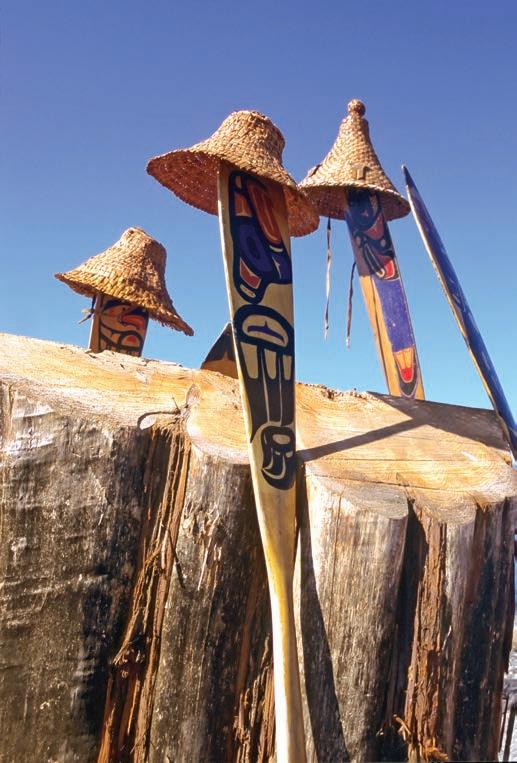
And so, it is said that when Europeans first sailed into the Salish Sea, they couldn’t see the land through the trees, meaning the trees were so large, the forests so dense, that the earth upon which they grew was obscured. It is said that you could walk across a river on the backs of salmon, there were so many. We still say, “When the tide is out, the table is set” because crab, oysters, clams, and all manner of shellfish can be harvested. Our foods, our medicines, our materials for our clothing and shelter, were all there in the forests, the rivers, the sea. In our language there is no word for famine. Our ancestors lived in a land of abundance and generosity.
As with other Indigenous peoples, our ancestors listened to the lands and the waters and learned how to be here. Some people call this knowledge and these practices the original instructions, or ancestral teachings, or Indigenous wisdom. Creator, ancestors, the plants and animals, the lands and waters, the place itself: these are the source of our knowledge and traditional lifeways that have been handed down from generation to generation since time immemorial.
Our ancestors understood that everything is alive, everything is filled with spirit, and we are all Mother Earth’s children. They knew that humans were the youngest (most pitiable!) siblings in the family, and that we lacked the gifts of wings, of fins, of claws, of fangs, of fur, of speed, that our older siblings had. Our ancestors knew that we humans relied on the generosity of the cedar trees, the salmon, the medicine plants. This is why, when we harvest something, we always say hy’shqe (thank you).
There’s a deep strand of common sense in Indigenous wisdom. Our ancestors understood that if they harvested everything one year, the next year there would be nothing. Never take the first nor the last; only take what you need. For instance, our
fishing technologies were designed to always let some fish go, to ensure the future generations of fish.
Because our ancestors understood that they were part of a family, they were in relationship with this place, with all the plants, animals, earth, water, and sky. Healthy family relationships are not transactional; they are understanding, loving, and reciprocal. We take care of the earth that gives us life and takes care of us.
Since time immemorial, generation after generation, our people have fished, hunted, gathered together, laughed, held ceremony, and lived life in all its fullness on and around the archipelago now known as the San Juan and Gulf Islands (in the US and Canada, respectively). To acknowledge Native land is to acknowledge that this place is filled with the spirits of our ancestors, of our beloved family members. To acknowledge Native land is also to acknowledge that Native peoples are still here.
We are all treaty people
There are hundreds of thousands of Native and First Nations people living in the Pacific Northwest. In Washington state, many of us live on reservations that were created by treaties signed between Native peoples and the United States government.
mountaineers.org 17
Paddles and hats. Several paddlers left their paddles and cedar bark hats near an old Western red cedar stump. From the Paddle to Lummi 2007.
The treaties were an attempt to secure land for settlement by non-Natives without engaging in costly warfare. Tribes that signed the treaties were promised reservation lands and various benefits. Further, the treaties protected the tribes’ rights to hunt, gather, and fish in usual and accustomed territories “for as long as the mountains stand and the river runs."
It is widely accepted that treaties are to be enforced in the way that the signatories understood them. When the treaties were signed, the rivers ran free, salmon were abundant, the Southern Resident Killer Whales numbered in the hundreds, the forests were thick, the air was clean – the Salish Sea was alive and healthy. The treaties guarantee our rights to exist, hold ceremony, hunt, gather, and fish in such abundance.

When you say the words of a land acknowledgment, you are saying those words on treaty territory. If you are not Native, your right to be here rests on the treaty, and on upholding the treaty. We are all treaty people. Our collective treaty obligation is to protect Native rights to fish, hunt, and gather, which means we must restore the natural abundance and vitality that were present at the signing of the treaty.
A teaching: the story of Salmon Woman
Like many peoples whose traditional lifeways are centered on salmon, Lummi holds a ceremony every spring to celebrate and give thanks for the return of the salmon. Every year, the story of Salmon Woman is told.
The story tells how, when Salmon Woman saw that the human people were starving, she sent her children to feed
them. The humans thrived, eating the salmon, but then they began to take the salmon for granted. Salmon Woman called her children back to her. The people starved again. Salmon Woman again took pity, sent her children to feed the humans, but this time with a warning: if her children were ever abused or neglected or unappreciated again, she would take her children away forever.
Some salmon runs have already gone extinct, and many others are struggling. We have taken Salmon Woman’s children for granted; we have not taken good care of the Salish Sea, the rivers, the air, the forests, and so now Salmon Woman is calling her children back to her. As the salmon struggle, so do Native peoples and the killer whales who depend on salmon. If the Salish Sea and all its rivers cannot support salmon, killer whales, and Native peoples, soon it will not be able to support others who live here as well.
How do we show Salmon Woman that we are listening?
In our First Salmon ceremony, the first harvested salmon of the season is shared amongst all attendees (the gathering is large, so the portions are very small). After the meal, the salmon’s bones are collected, and then ceremonially given back to the sea. This is an act of acknowledgment, of thanks, of honoring.
Acknowledging that you stand on Native land is the first step in honoring the land. You honor the land by opening your heart and mind, and then by taking action.
18 mountaineer | fall 2023
The arrival of canoes at the Canoe Journey 2019 hosted by the Lummi Nation.
Ways to Take Action Beyond Land Acknowledgment
As you live, work, and recreate on the lands and waters of the Pacific Northwest Indian tribes, here are some ways you can take action beyond land acknowledgment toward a healthy, thriving Salish Sea.
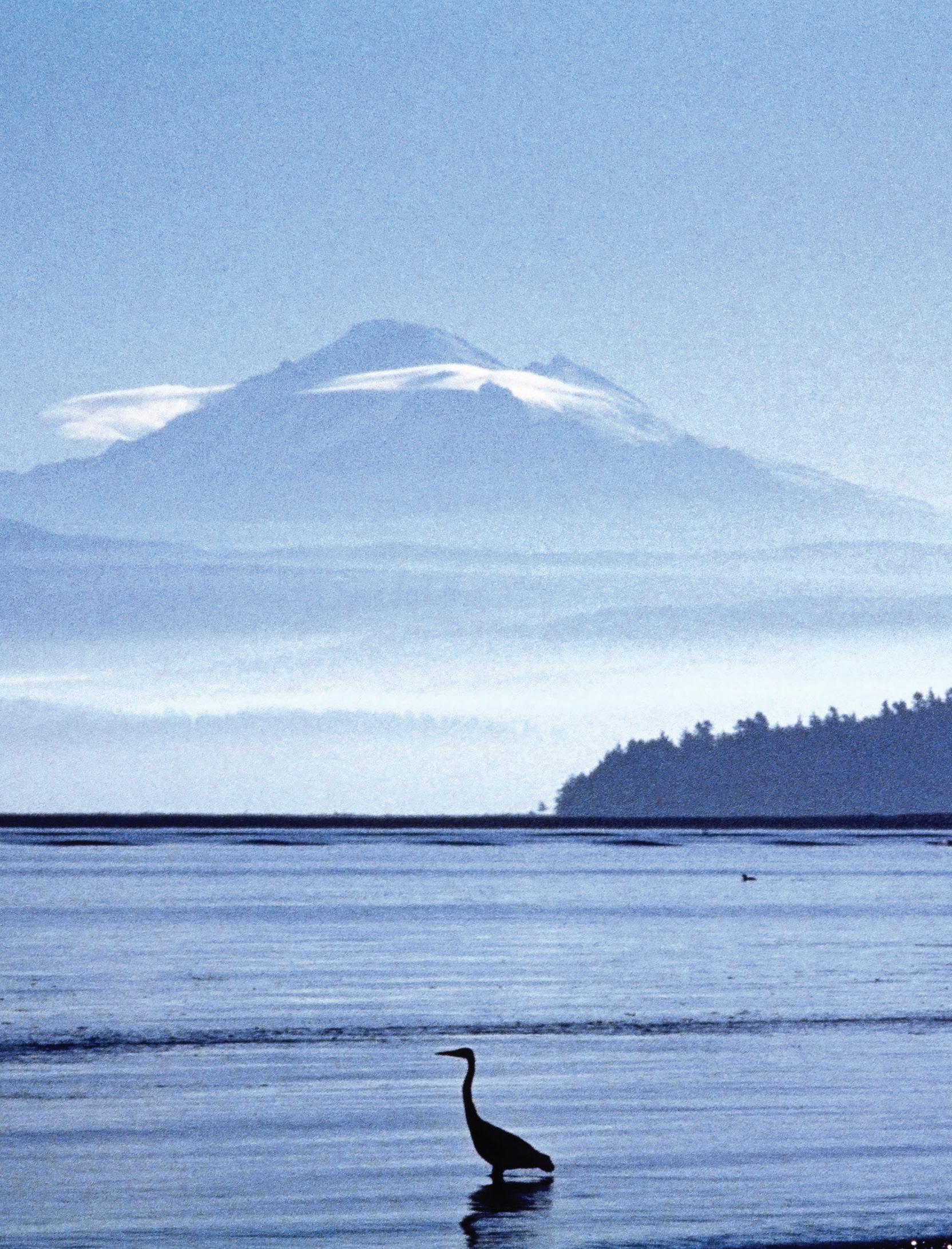
Practice gratitude, generosity, and humility
As you recreate and enjoy these lands, know yourself to be part of the ecosystem, not a visitor to it. Go beyond “Leave No Trace” and into deep witnessing. Ask yourself “how are the lands/waters/other living things doing?” Take care of the land as you would a beloved. When you honor the land, you honor its people.
See place, not borders
Start to see how geography, climate, culture, Indigenous languages, and kinship ties – rather than geopolitical borders – define a place. There are no fixed boundaries defining a spiritual, cultural, and physical ecosystem. Territories overlap, but there is a sense of wholeness.
Learn the names & history of the places where you live, work, and recreate
Some names share good information and deeper meaning about a place. For instance, the place name Olalla (in what is now known as Kitsap County) is a variant of a Salishan word meaning berries, because Saskatoon berries grew there in abundance. On San Juan Island, Deadman’s Bay is just below Smallpox Bay. Why? When smallpox was ravaging Native peoples on the island, they’d wade into the water to cool their fevers in one bay (Smallpox) and then their bodies would wash ashore at another (Deadman’s).
Work to restore wild salmon runs
We can all help restore our region’s wild salmon runs through small gestures like avoiding farmed (Atlantic) salmon, and larger actions like supporting the Indigenous-led call to breach the four lower Snake River dams.
Read works from Indigenous writers
Robin Wall Kimmerer’s Braiding Sweetgrass and Tyson Yunkaporta’s Sand Talk are excellent introductions to basic Indigenous principles. Local Indigenous writers with books of fiction, non-fiction, memoir, or poetry include Sherman Alexie, Rena Priest, Sasha LaPointe, and Charlotte Coté.
Learn more about Indigenous culture by visiting a museum, attending a community event, or watching local Indigenous films.
Here are some to consider:
• The Tulalip Tribes’ Hibulb Cultural Center
• The Suquamish Museum
• The Burke Museum, which works with Pacific Northwest Coast communities and artists to share culture in a good way
• The annual Indigenous Canoe Journey, which brings canoe families from near and far to paddle through the Salish Sea. Landings during which welcome protocols are followed are typically open to the public
• The annual Gathering of the Eagles Canoe Journey and potlatch, which brings regional canoe families together to paddle through the San Juan Islands during Memorial Day weekend. Landings with traditional protocols are hosted by local island communities and are open to the public, as is the final landing at Lummi Nation
• The Lummi Nation’s annual Stommish Water Festival
• The Makah Tribe’s annual Makah Days celebration
• Children of the Setting Sun Productions is a Lummi production company with films on treaty rights, salmon, and other issues
Teach your family the full history
Places hold the past as well as the present. Acknowledging that these lands are Native lands means acknowledging history. There is power in knowing the truth, in knowing what kinds of actions lead to suffering as well as to joy. Teach children without guilt or shame, but also let them know the true and full history of these places. Let your children know that Indigenous peoples have always lived here, and that there are good, life-sustaining ways to live here. Teach them that they belong to a place but the place does not belong to them. Teach them to be grateful and generous and full of love for this place and for one another.
Support Indigenous calls to action, policies, businesses, non-profit organizations, and institutions
Ancestral wisdom of Indigenous peoples can show us ways to get back into a right, reciprocal relationship with Mother Earth. Supporting the people who carry these teachings, and the causes they advocate for, are ways to help protect and share ancestral wisdom. We all rise when we lift up each other.
mountaineers.org 19 Winter sunrise on Mt. Baker, taken from Lummi Island.
TOP TIPS FOR SHOULDER SEASON BACKPACKING
By Rob Erickson, Backpack Leader
Iwas forty years old when I went on my first backpacking trip. We visited Second Beach in Olympic National Park, and the experience left me hungry for more. I had to go again, first with friends who mentored me, and then solo. I couldn’t get enough.
About a year later, I had a revelation that I should bring my kids along on these adventures. Four little ones, dad, and two tents hit the trail. My vision of what backpacking could be was growing.
On a solo June trip in the Teanaways, I encountered significant snow at Navaho Pass and knew I was in over-my-head. I needed more training. So at fifty, I joined The Mountaineers (clearly one of my better life choices) and took the Scrambling course, where my vision of what could be (off-trail travel) expanded once again. Shortly thereafter, I became a Backpack Leader.
Not satisfied with the seeming brevity of the backpacking season, I began to push the boundaries of backpack trips — venturing out beyond the idyllic months of July to September. Having soon exhausted the early season trips The Mountaineers has traditionally offered, I began to develop my own new, original backpacking routes that would extend the season further.
In developing shoulder season backpacking trips, I began by focusing on existing trails, routes, and access points, saw to it that there was reliable water, and sought out appropriately spaced camp sites. Often known day hikes were connected with off-trail segments to make a workable three-day trip. Once I got a handle on designing these early-season trips, I extended my research and trip design to late-season/fall trips.
Eventually, I had enough beta and extra-early and extra-late season trip possibilities and experiences to create the first Mountaineers Shoulder Season Backpacking course in 2022.
What is shoulder season backpacking?
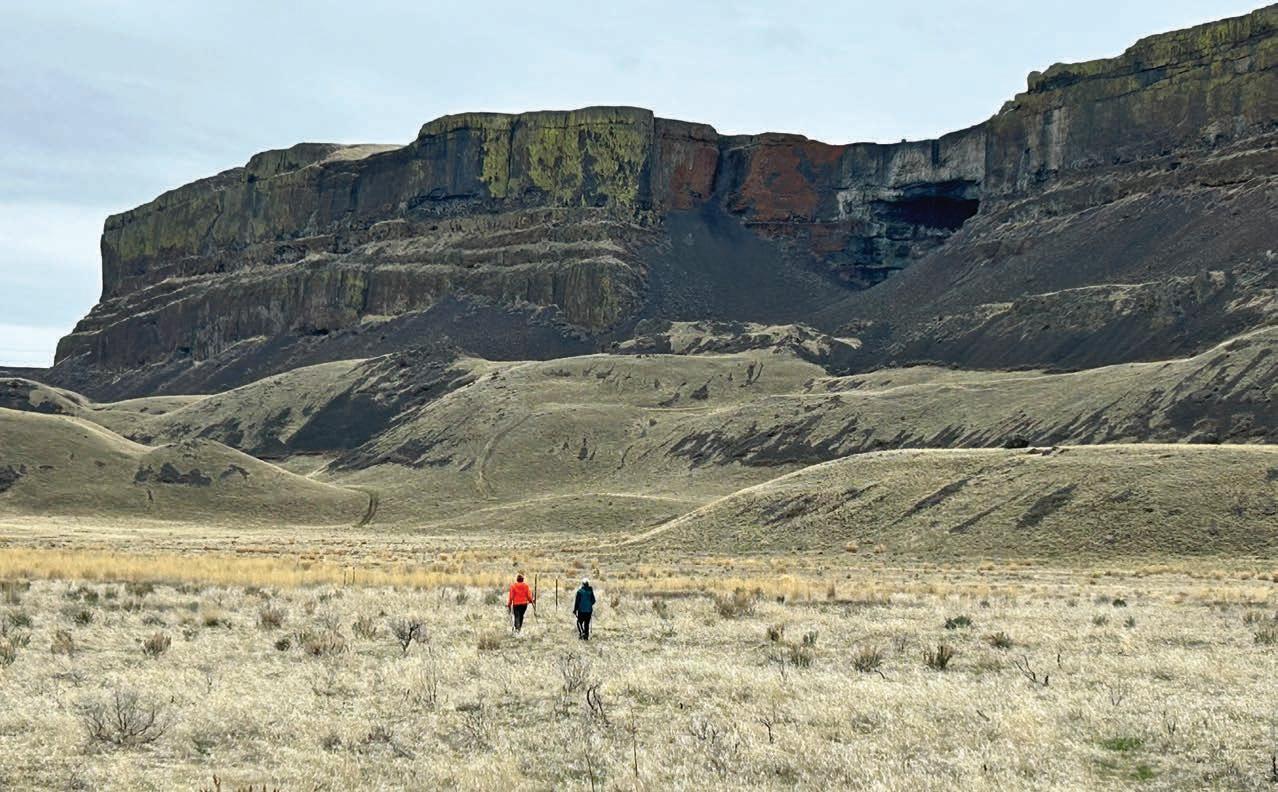
Shoulder season backpacking is backpacking in the darker and wetter months, roughly October through May. It is an attitude of embracing the beauty of the desert and/or the mid-fall chill. Shoulder season trips require you to push through the logistical challenges to jump at that early first trip of the year or sneak in an extra-late trip before the winter comes. You’ll find these to be different experiences than the high, alpine meadows or warm, lakeside camps of summer. These backpacking trips offer a more subtle, but no less refreshing, escape.
What you’ll love
This season provides some delightful surprises, including wide-open spaces, amazing late-fall colors, early-season wildflowers, and frequent sunshine. One of the big draws is the respite the Central Washington desert offers from Western Washington’s rain and clouds. While March and April in Seattle are likely to be 50s and rainy, it is frequently 60-65 degrees and sunny in Vantage, just two hours away. The desert areas, more accurately known as the shrub-steppe ecosystem, have a unique beauty with amazing basalt rock formations, unique wildlife, and unusual plants. Spring trips can offer several hundred different types of flowers in bloom, and late-fall trips dazzle with golden larches and red huckleberry foliage. Winter trips to the ocean have also been surreal.
20 mountaineer | fall 2023
Exploring Banks Lake. All photos by Rob Erickson.
What you’ll find challenging
The challenges of shoulder season trips are many. The most significant issue is darkness. The night is long lasting: 1016 hours in the mid-fall to early-spring months. Night-time temperatures at or below freezing are common. Additionally, snow on the trail, at the camps and access roads, or on the highway passes (most trips require crossing Snoqualmie or Stevens Pass) needs to be considered. You need to pay close attention to the weather. Often trips are done spontaneously when a dry weekend is forecasted, and many times rescheduled when a storm is approaching. Participants need to have comfort with the unknown and the flexibility to adjust the trip as they go. Almost all the shoulder season trips I lead incorporate off-trail travel. Most off-trail routes are not hard, but do require navigation skills and some experience and comfort being off the trail.
For more information, training, and field trips for early and late-season backpacking, sign up for Rob’s Shoulder Season Backpacking course offered in winter 2024. Visit mountaineers.org to learn more and register.
TOP TIPS TO MAKE THE MOST OF YOUR SHOULDER SEASON BACKPACK

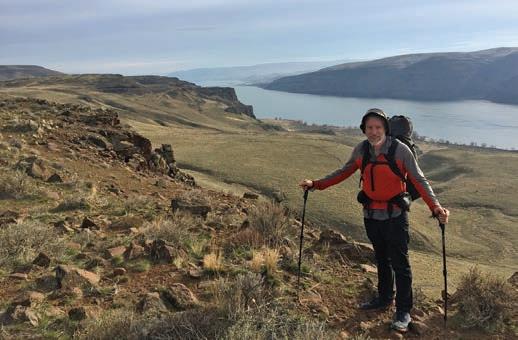
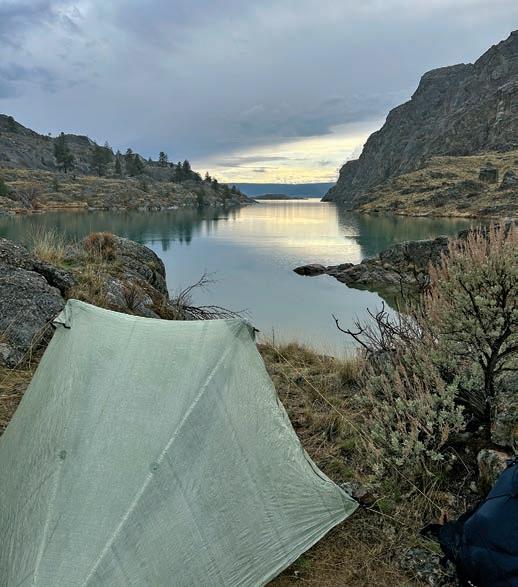
Plan thoughtfully. Each day needs to be thoughtfully choreographed to fully utilize the short daylight and best enjoy — or endure — the long nights. My groups often enjoy an hour or two around a campfire after dark and then pursue personal movies, podcasts, or music in their tents until sleepy. Personally, I don’t mind going to bed early so I can catch up on sleep for 10+ hours.
Pack for colder temperatures. The mornings are always cold — pack that puffy. Don’t forget to bring those down pants; and down booties are nice too. If the ground is frozen or covered in snow, two pads are a must to reduce heat loss via conduction. Keep in mind that packs are often a bit heavier with this added gear. Pick the right location. Most late-winter to spring trip locations center around the Columbia River between Wenatchee and Vantage and in and around the Yakima River Canyon between Ellensburg and Yakima. There are also routes near the Tri-cities, Banks Lake, and on The Deschutes River in Oregon. The best October to early November trips are on the eastern slopes of the Cascade mountains and feature either the brilliant golden hues of the subalpine larch (about the first week of October) or the western larch (late October to early November).
Know your land managers. Land management regulations for these trips are varied. Most of the desert areas are Washington State Wildlife Areas, managed by the Washington Department of Fish and Wildlife (WDFW). Some are managed by the Bureau of Land Management (BLM). Both of these agencies generally allow unlimited access and dispersed camping. A Discover Pass is required for trailheads managed by Washington State and an America the Beautiful Pass (Federal Lands Pass) is required for trailheads managed by BLM. Campfires are often prohibited after about April 15 on the state lands, but you should check specific restrictions for the area you are visiting at the time of your trip.
Hiking along the Deschutes River.
Camping at Banks Lake.
mountaineers.org 21
Rob at Frenchmen Coulee.
THE PRIVIEST VIEWS IN WASHINGTON
By Kristina Ciari, Membership &
Director
When you're sourcing content for a story about outdoor toilets, your first thought probably isn’t, “I’m going to make my mom so proud.” Well, your mom isn’t a copy editor for this magazine, but my mom is, and when I told her about this article, the first thing she did was groan and say, “Oh Kristina. You aren’t writing about poop again, are you?” Full of unconditional love, she did a quick course correction. “It has been about a year since you wrote about poop, so I guess this makes sense.”
What can I say? I am completely regular. By which, of course, I mean that I have always loved good bathroom humor. Research would suggest I am not alone. When we posted asking for submissions for this article, more than a hundred people shared photos and stories from encounters of the brown kind. A loo with a view, or poo with a view, seems to be the uniting topic everyone on the internet was looking for.
Appeal of outdoor thunder buckets
Outdoor toilets, aka backcountry or alpine privies, come in all shapes and sizes (and smells). Despite their variability, these commodes seem to be universally loved. Where else can you make uninterrupted eye contact with a marmot – or in scary cases, a mountain goat – while answering the call of nature? Contend with wind or snow or lightning while avoiding splinters from a wooden toilet seat? Confront the dangers of mosquito bites and sunburns in sensitive areas at the same time?

Whether you’ve been looking forward to the potty break for five hours or five minutes, there’s nothing quite like the feeling of throwing off your heavy pack, sitting down, and letting it all go. Plus, if you poop in a hole, you aren’t carrying that
baggage out with you. These thrones offer a literal lightening of the load, if you will.
Classic craps of the PNW
For this article, we were looking specifically for the best – or priviest – views from outdoor toilets in Washington. (One commenter noted that any privy can be an alpine privy if you leave the door open, which is absolutely correct.) Nominations flowed in from across Washington state. We saw cliffside, water side, and mountain side options. Folks also shared a few back-toback – or crap-to-crap – options. It seems that even backcountry rangers think that outdoor pooping is better with friends.
The installers of the Lake Serene privy would agree. “The toilet at Lake Serene has a decent view, but the fun part is that it’s slightly elevated with no tall vegetation between you and the trail,” said outdoor powder room user Christopher Blodgett. “You go into the woods thinking it’s private, and once you’re settled in, people walking down the trail are in full view and at eye level with the toilet. The toilet faces the trail, so if anyone happens to turn their head, it’s an awkward staring contest.”
The bottom line: we saw a lot of crap for this article, but our committee of dedicated staff poopers couldn’t pick a favorite. And why should we? All of the nominated crappers rate well above a 10 and offer their own special adventure. From Lake Chelan to the Wonderland Trail to Gothic Basin, we loved all your stories and the memorable trips they represent. Each one is unique, and from what we hear, well worth the visit.
Personally, I’m excited to share that after perusing all of the incredible privy views, I have a new type of bucket list. That's right. I went there. My mom will be so proud.
22 mountaineer | fall 2023
Communications
This wooden privy has larches and a view of Mt. Shuksan. Best in fall. 13/10. Photo by Terry Galiney.





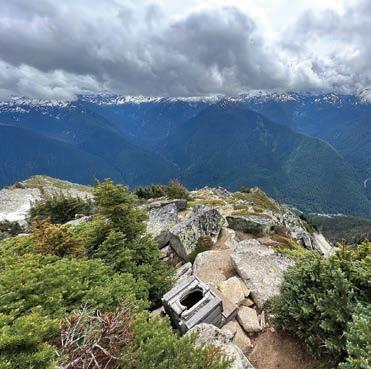


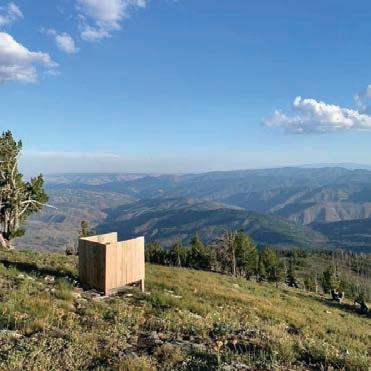 This is the Snow Lake poop hole. Can’t complain about that view. 11/10. Photo by Sharon Barnard.
This commode overlooks Boston Basin. It even has a plastic seat. And sunset views. 14/10.
Photo by Eli Mauksch.
This super pooper is big enough for two. Poop with friends! 12/10. Photo by Melinda Harris.
Peak a poo! This loo comes with a view of Desolation Peak. Extra drum for overflow storage. 13/10.
Photo by Monica Price.
This is a true alpine throne. Few views are privier. If Eldorado wasn’t on your list before, it is now. 14/10.
Photo by Brandon Hoxie.
Lookout for splinters at this Hidden Lake thunder bucket. What a place to breathe in the fresh mountain air. 11/10. Photo by Olga Toropova.
This Red Top Lookout privy has a door, walls, and sloughs snow like a boss. At least the door is a little broken, so you’ll never be truly alone. 12/10.
Photo by Alana Miller.
This enchanting hole gazes longingly at Prussik Peak. You’ll want to stay a while. 13/10.
Photo by Angela Argyropoulos.
The hills are alive with the views from the Tyee Lookout potty box. Clouds, grass, and trees? Yes please! 12/10.
This is the Snow Lake poop hole. Can’t complain about that view. 11/10. Photo by Sharon Barnard.
This commode overlooks Boston Basin. It even has a plastic seat. And sunset views. 14/10.
Photo by Eli Mauksch.
This super pooper is big enough for two. Poop with friends! 12/10. Photo by Melinda Harris.
Peak a poo! This loo comes with a view of Desolation Peak. Extra drum for overflow storage. 13/10.
Photo by Monica Price.
This is a true alpine throne. Few views are privier. If Eldorado wasn’t on your list before, it is now. 14/10.
Photo by Brandon Hoxie.
Lookout for splinters at this Hidden Lake thunder bucket. What a place to breathe in the fresh mountain air. 11/10. Photo by Olga Toropova.
This Red Top Lookout privy has a door, walls, and sloughs snow like a boss. At least the door is a little broken, so you’ll never be truly alone. 12/10.
Photo by Alana Miller.
This enchanting hole gazes longingly at Prussik Peak. You’ll want to stay a while. 13/10.
Photo by Angela Argyropoulos.
The hills are alive with the views from the Tyee Lookout potty box. Clouds, grass, and trees? Yes please! 12/10.
mountaineers.org 23
Photo by Michael Chipman.

“You only have one life, but if you live it well, that’s enough.”
–Isabel Allende
 This camouflaged commode hides in Hannegan Pass. It comes with wildflowers galore and views for days. 14/10. Photo by Brooke Kisser.
This camouflaged commode hides in Hannegan Pass. It comes with wildflowers galore and views for days. 14/10. Photo by Brooke Kisser.
It was November 2018, and I was sobbing in my car at the Seattle Bouldering Project (SBP). David had just broken up with me. He was a skier, mountaineer, and climber I’d met six weeks prior. I’d fallen head over heels with both him and the rock climbing hobby he introduced me to. As I stared at the steering wheel, tears blurring my vision, I felt shattered and confused. Why was I so devastated by the end of a relationship that lasted only six weeks and had more red flags than a circus tent? After all, he broke up with me because, as he said, winter was prime time for skiing and mountaineering, and he wouldn’t have time for dating. It did not take Shakespeare to see that this wasn’t a Romeo and Juliet situation.
Discouraged, I returned to running, the first sport I had fallen in love with and the sport that had always brought me mental clarity. With nothing but the percussive thwap of my sneakers to distract me, I assessed my mess of feelings and finally came to the realization that my devastation had little to do with David and far more to do with my loss of a gateway to the world of outdoor adventure.
BREAKUPS AND BREAKTHROUGHS Finding my Independence in the Outdoors
 By Christine Leibbrand, four-year member
By Christine Leibbrand, four-year member
Unveiling my hero’s journey
I have always been intrigued by hiking, mountaineering, and climbing. I grew up ogling epic pictures of my dad — a talented skier and mountaineer — soaring over snowy cliff faces in his 80s-era skis and listening to stories about him and his friends summiting local mountains. (In one particularly notorious story, his sleeping bag fell from his pack, ping-ponging into a crevasse. He spent that cold night huddling with his climbing partners for warmth in an unexpected white-out.)
My dad’s stories sparked an interest in adventure that was further fanned by hours reading books about Hobbits, wizards, and non-magical folks going on epic journeys. I, too, wished I could go on a long, hard walk to save the world (if only that’s all it took!). However, with no wizards arriving to guide me, I contented myself with climbing trees in my backyard, writing adventure stories on a clunky desktop computer, and occasionally skiing and camping with my family.
You might wonder why I didn’t ask my parents to enroll me in
26 mountaineer | fall 2023
Christine at the summit of Mt. St. Helens. Photo by Andrew Lapinsky.
outdoor or climbing programs. I saw myself as a shy, nerdy girl. And the shy, nerdy girls I saw on TV were not athletic. They did not go on adventures. They read books and had makeover montages. They certainly didn’t climb mountains or rock walls. I had seen so many stories about shy, nerdy girls that I started telling myself those same stories until I believed them. But somewhere buried underneath that fictional narrative was a little burning truth that I loved adventure and testing my limits.
Which brings me back to that SBP parking lot. In that moment, crying over David, I unearthed my truth. I could no longer wait for a guide to lead me on an adventure. I would need to do it myself.
The call to adventure as an independent woman


Feeling broken-hearted but emboldened, I embarked on my solo journey into the outdoors. I booked snowshoe day trips, and signed up for first aid, navigation, climbing, and mountaineering classes. I researched nearby, well-trodden hikes that I felt safe hiking as a solo female with limited outdoor experience.
My first forays into solo adventuring were fraught with nervousness. For one thing, I rarely did anything other than running on my own. I had grown up, as many women do, with the sense that being alone meant being vulnerable. With nothing but the sound of my own thoughts for company, it was easy to dwell on stories I had heard or just imagined about women harassed or attacked on trails. My atrocious sense of direction only increased my feelings of anxiety.
As I sat atop Mt. Si one December morning, gnawing a rockhard granola bar that a Canadian Jay was beadily eyeing, I realized I was stronger and more capable than I had given myself credit. I had persevered through this hike and a growing number of challenging others, learning more about myself and hiking along the way (like how granola bars get rock-hard if you store them in the top of your pack during winter). Plus, I hadn’t gotten lost once.
To sum up, I had my nerdy girl makeover montage. But instead of taking off my glasses and putting on a short skirt, I loaded up on moisture-wicking base layers, waterproof pants, and a newfound sense of confidence that had nothing to do with how I looked to others and everything to do with embracing a sense of self I had long denied. I didn’t need anyone else to affirm my self-worth when I woke up early, drove to Mt. Si, and cruised up the mountain before lunch, all in the revelry of my own solitude.
Fighting fears and finding friends
My confidence was further bolstered by confronting another fear: socializing with strangers. I had always been shy and quiet. However, I desperately wanted to find community in the outdoors, particularly with other women. At the end of each group class or excursion, I made it a goal to ask a fellow woman on the trip if they’d like to hang out in the future,
putting my once crippling sense of social anxiety to the side in the interest of greater female empowerment and connection. I also rekindled old friendships with women who loved hiking and climbing as much as I was growing to. One friend patiently coached me as I attempted difficult climbs, suggesting footholds or explaining techniques like stemming and heel hooking. She cheered my successes and consoled me when I became frustrated with a route, building my confidence all the while.
I found a new sense of connection to my dad, too. We planned hikes and ski trips together, and bonded over beautiful scenery, chairlift rides, and the damp weather that was an inevitable result of me discovering my love of the outdoors in late November. He re-told stories of his youthful adventures, and we realized that we shared more dreams than we previously thought, or, in my case, admitted. He had also summited Mt. Rainier, and I finally vocalized a childhood dream that I wanted to follow in my dad’s footsteps and make my own attempt at its summit.
mountaineers.org 27
Christine climbing at Mt. Index. Photo by Andrew Lapinsky.
Christine stopping for a snack break during the summit of Mt. St. Helens. Photo by Andrew Lapinsky.
A dream a lifetime in the making
It was the summer after that infamous breakup that my Mt. Rainier dream started falling into place. I met Andrew — a supportive and adventurous man who wasn’t intimidated by the independence I had progressively built — and booked us two spots on an expedition to summit Rainier in the summer of 2020 (which would eventually get rescheduled due to COVID). I would finally, weather permitting, achieve the dream that I had quietly harbored since childhood.
I threw myself into training, developing a plan with hikes that gradually increased in distance and elevation, tailored to the season. Many of the early hikes I had soloed featured in my trail plan and took on new meaning as I lumbered up them, weighed down by a pack stuffed with sandbags and water bottles. My runs also took on new meaning as I incorporated more hills, strengthening both my quads and tolerance for discomfort.
More importantly, I loved the training process. While hiking had quickly become a passion, making time for it felt difficult. However, the Mt. Rainier trip forced me to make hiking a priority. Every other Saturday I woke up at 5am and arrived at the trailhead with the sunrise. Each hike offered something new, even if I had done it before. One hike involved an unexpected snowstorm that required some off-route navigating I had learned in my classes. And after a rain-soaked hike at Mt. Teneriffe, I cheered all I had learned about proper weather-appropriate gear, having ended the hike feeling only somewhat uncomfortable.
Everything was going great. I could carry a 40-pound pack without much difficulty, despite being roughly the size of a sixth grader. I summitted Mt. St. Helens on a gorgeous bluebird day, with plans to attempt Mt. Adams in early summer. Plus, I hit the unofficial benchmark of climbing Mt. Si in under 1.5 hours with a fully-loaded pack.
My climbing and running had also improved. After Mt. Rainier, I planned to run my sixth marathon and was hoping to set a personal record and qualify for the Boston Marathon.

My literal Achilles heel
I was feeling stronger than I ever had before, not just physically, but mentally as well.
Then, only two days after paying the non-refundable, full amount for our Rainier trip, I tore my Achilles. I was trudging up Mt. Si, hauling a 40-pound pack and attempting to heave my diminutive, 5’ 1” body up a flight of steep steps when it happened. It felt like someone had stabbed me. I continued hiking, feeling confident that the pain was the result of something lodged in my boot. But the pain only worsened.
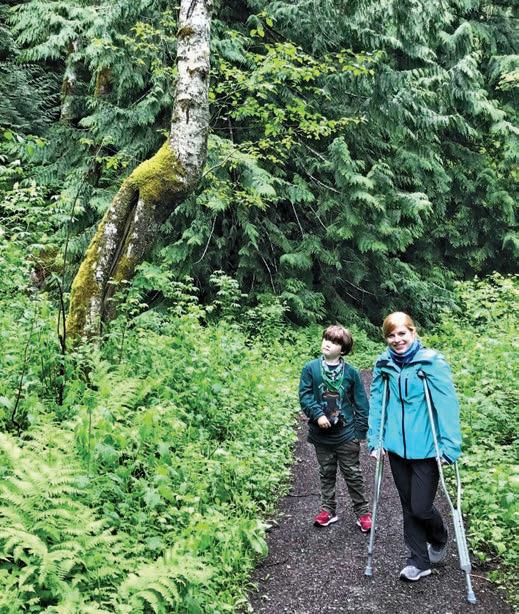
The thought crossed my mind, “What if it’s my Achilles?” I had always feared an Achilles injury more than anything. I knew it meant a long recovery and a complete hiatus on all my favorite activities, summitting Mt. Rainier certainly among them.
On the drive home, I inspected my heel. It looked okay, although I wasn’t really sure what my heel looked like before. Unlike my pores, I hadn’t scrutinized my heels on a daily basis
Christine hiking with her nephew and Dad after her Achilles injury.
28 mountaineer | fall 2023
Photo by Brad Leibbrand.
Christine hiking the trail to Machu Picchu. Photo by Christine Leibbrand.
so what was a normal heel supposed to look like? I rested for a couple days until I decided that the pain had been nothing more than a skin irritation.
I walked to the local climbing gym, excited to be active again. After attempting a tricky route, I fell off the wall and felt a stabbing pain so intense I had to hobble off the mat. Undeterred, I bandaged my heel and continued climbing. It was while stemming the wall, my legs in an almost split, that the pain became too unbearable to chalk up to a skin injury. I walked home (another bad idea), booked an appointment with a physical therapist, and within 24 hours found myself on crutches, unable to walk a block without pain. The diagnosis confirmed what I’d been trying to ignore.
Here comes another montage, one that’s a little more pathetic and with Tom Petty’s “I Won’t Back Down” playing in the background. I threw myself into physical therapy, got biweekly acupuncture, foam rolled my calves until my shoulders seized, consumed buckets of bone broth just in case it was the magic bullet, and researched every possible therapy to get better quickly, all in the hopes of being able to attempt the Rainier summit. I didn’t back down until I had to.
My own long, hard walk

The Rainier trip was three weeks away and I could walk five blocks — five flat blocks. I had to accept that my nerdy-girlturned-outdoor-adventurer story would not feature a Rainier summit. Crying harder than I did when David broke up with me, I emailed the mountaineering company and told them I was too injured to join the climb.
Three weeks later, I said goodbye to Andrew as he hauled his pack, ice axe, and hefty supply of gummy candies to the car. I did my best to be supportive and gracious, to see this as an AFGO (another f*cking growth opportunity), but I may have cried a lot when Andrew called me and relayed how everyone on the team was really nice, or when I crossed the 520 bridge and saw Mt. Rainier brazenly on display, or when I texted Andrew “good luck” and had to remind myself that I meant it.
But then came a big moment for me. I was cleared by my physical therapist to start running. It was only for a minute at a time: one minute of running, one minute of walking, alternated 10 times. However, it was still a milestone. I missed hiking and climbing bitterly, but I was surprised to find that I missed running the most. Running was my first love, the first hobby that got me outdoors on my own, and the first that showed me my strength.
I couldn’t summit Mt. Rainier, but those 10 minutes of running showed me that I was summiting my own mountain. Yes, my mountain only looked like the size of a very swollen Achilles tendon, but it was comprised of all my fears of missing out and of dreams unrealized. If I could run for 10 minutes when I could barely walk five blocks the month before, I could summit Mt. Rainier one day, or any other mountain for that matter.
The next day I got a text from Andrew. He had gotten altitude sickness 1,200 feet from the summit at Disappointment Cleaver and had to turn back. In that moment I knew I genuinely had been rooting for him and wanted him to summit. I was disappointed he didn’t get the outcome he wanted, but proud of both of us for giving it our all.
I might try to summit Mt. Rainier in the future, but I also might not. Sometimes dreams change and sometimes the pursuit of the dream is more important than the dream itself. It was the process of discovering my love for the outdoors, forging my own path, training for Mt. Rainier, and overcoming my injury that made me a stronger woman. I didn’t need a summit to prove how far I had come. While I don’t know if I’ll ever summit Mt. Rainier, I do know that I am forever grateful that years ago a boy broke up with me in a parking lot because that heartbreak took me on the greatest, most empowering adventure I ever could have imagined. So wherever you are, thank you David.
 Photo by Skye Stoury.
Christine and Andrew hiking in Iceland. Photo by Andrew Lapinsky.
Christine running in the Seattle Rock and Roll Marathon in 2017.
Photo by Skye Stoury.
Christine and Andrew hiking in Iceland. Photo by Andrew Lapinsky.
Christine running in the Seattle Rock and Roll Marathon in 2017.
mountaineers.org 29
Photo by Brad Leibbrand.
CLIMBING TO FALL IN EL POTRERO CHICO
By Scott Braswell, 17-year
&
Leader
My first fall is a well-mitigated disaster. Alvero performs his part flawlessly — the disaster is all mine. With my feet at about the height of a bolt and my knees bent, I cling to an awkwardly located crimp at my left shoulder and a side pull to my right, while twenty feet below me, Alvero explains to the group what he is going to do as I fall.
When he tells me to let go, I am more than ready. Or so I think. Instead of pushing off the rock to fall in a graceful arc and land with my feet into the wall as I should, I just let go and slide straight down the face. My feet shoot up over my head and I come to rest, dangling upside down with my back against the wall, uninjured and undignified.
This is how I spend my second day leading an Alpine Ambassador-Hosted Cragging Trip in El Potrero Chico, Mexico.
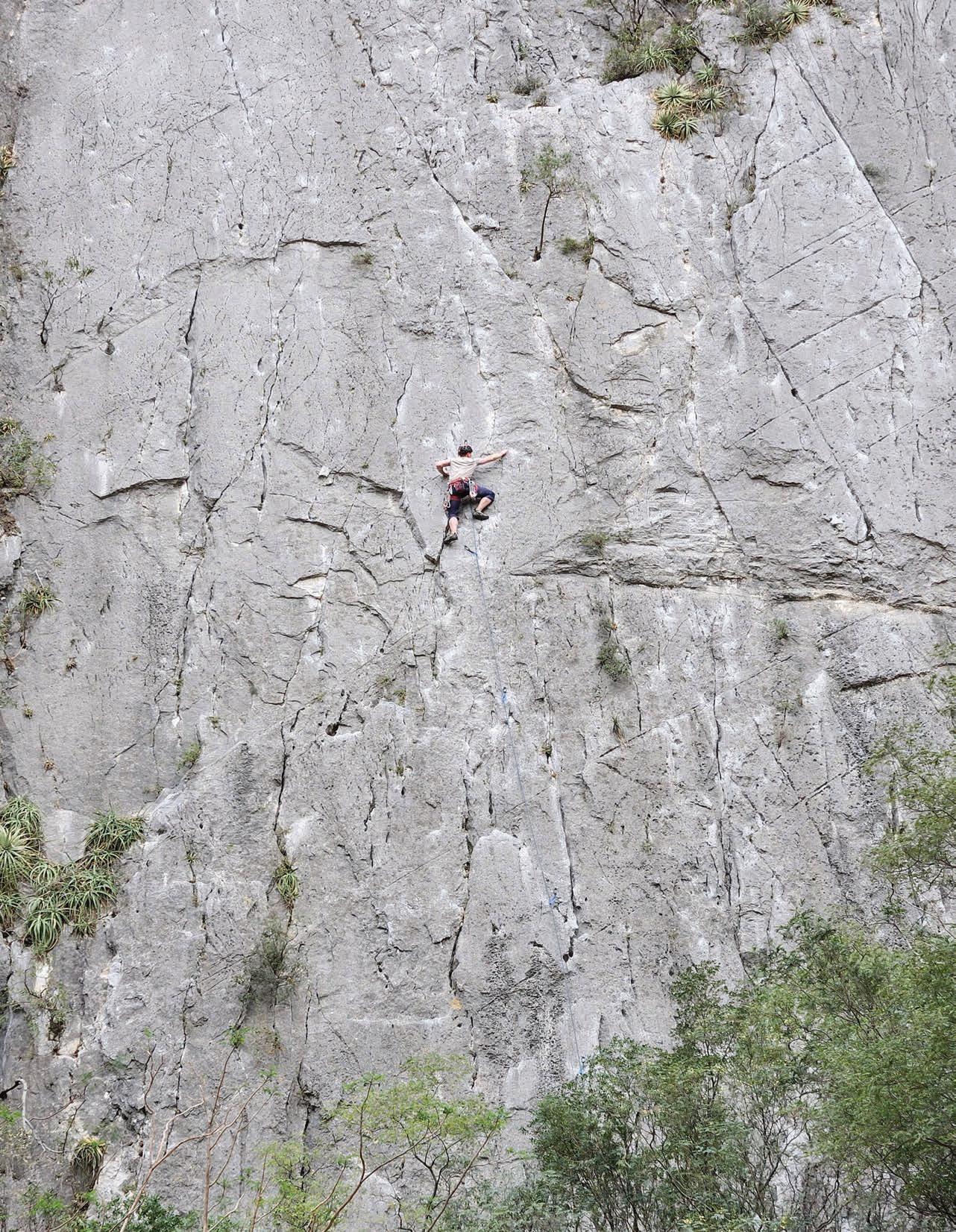
30 mountaineer | fall 2023
member
Climb
Scott on Selam, Lower Virgin Canyon.
Photo by Brian Degenhardt.
El Potrero Chico
“El Potrero Chico” means The Little Corral. It is neither little nor a corral, but it is smaller than its big brother, Potrero Grande, located a few miles across the valley. The park is managed by the state of Nuevo León, and is part of the Sierra del Fraile, a national protected area that includes a much larger territory spanning six municipalities. Home to a gigantic run-down water park (which, they tell me, is still open in the summer) and an abandoned mine that used to supply limestone to the local cement plant, El Potrero Chico’s towering rock walls form a kind of natural corral, encircling an area of almost 30 square kilometers. The 2,000-foot limestone stockade attracts the attention of most visitors.
On the weekends, families drive out from the nearby metropolis of Monterrey to stake out shady picnic shelters, their red painted roofs riddled with holes from rockfall. Children run back and forth tossing pebbles while their parents turn up cold drinks and watch crazy gringos scale lines of bolts up the massive walls.
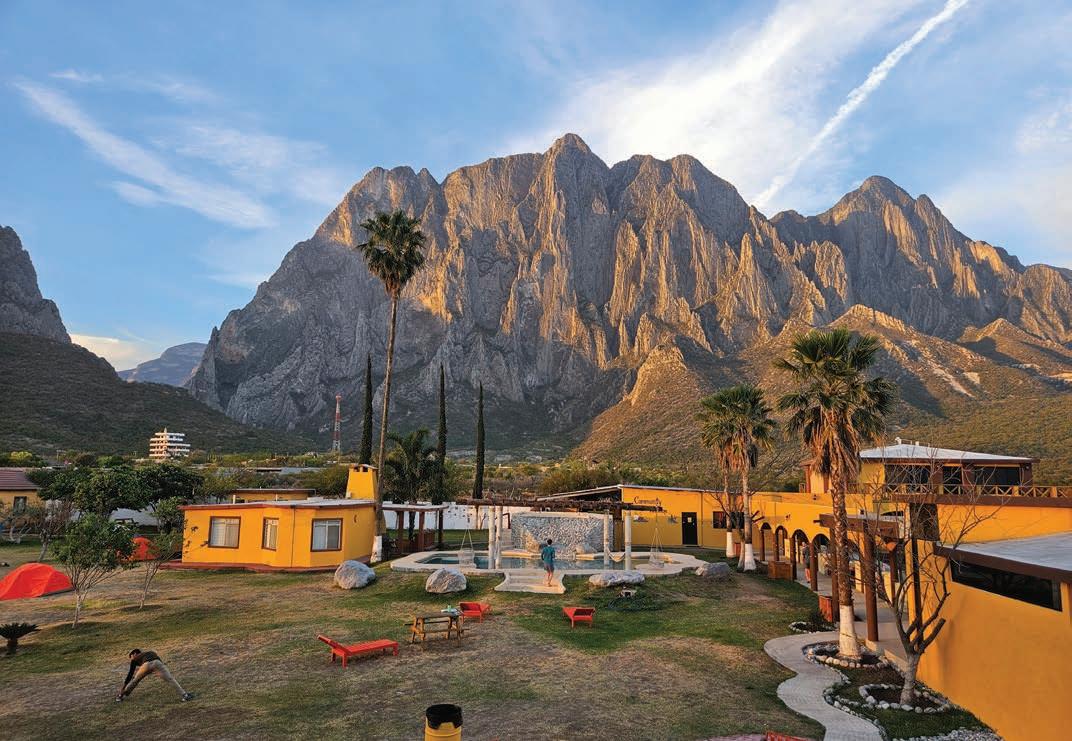
We’re not all gringos, of course. Climbers come to this internationally-renowned climbing destination from all over the world (not just North America). I meet people from Chile, Spain, the UK, and Canada during the week I spend here. This is my second visit to the park since “discovering” the place for myself in 2022.
Potrero, as its commonly known, was discovered by Mexican climbers in the 1970s, before the popularization of modern climbing gear. At that time, rock climbing was a wild and hazardous affair not for the faint of heart. Still, Mexican first ascensionists climbed bold 700-meter lines on El Toro with very little protection and left behind even less in the way of artifacts or records of their passage. In the mid1980s, a contingent of climbers from Austin, Texas, including the prolific route developer Jeff Jackson, moved into the area. They befriended Homero Gutierrez Villarreal, a local landowner, and launched a campaign of cleaning and bolting that spanned two decades and gave rise to the bedazzled Potrero Chico of today.
A Mountaineers contingent
Our group is eleven climbers in total, representing five branches of The Mountaineers. I’ve arranged for us to stay at the Rancho El Sendero, a yellow stucco motel and campground walking distance from the park. It has a beautiful campus dotted with orange trees, a swimming pool, and an epic view of the mountains. Seven of us share a no-nonsense bunkroom. The others opt for more private (though equally spartan) habitations at the other end of the building. By the end of the week, I am grateful that we’ve spread out and are therefore spared a bit of each other’s filth.
mountaineers.org 31
Rancho El Sendero. Photo by Brian Degenhardt.
I’ve been a Climb Leader with The Mountaineers for about six years, but I still have anxiety about planning and leading a trip in Mexico. In 2016, I went on a stressful, somewhat disappointing mountaineering trip to Switzerland with two acquaintances. The combination of technical mountaineering, international travel, and personality issues proved too arduous for some relationships to bear.

Potrero is not the Swiss Alps, however; and sport climbing is, well, sport climbing. There are objective hazards to be sure, like rockfall, rattlesnakes, and sun exposure, but following a line of 3/8” bolts with shiny silver hangers is relatively simple in comparison.
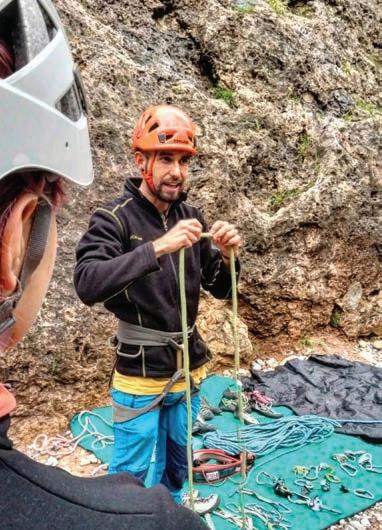


Warming up on the first day, we follow those bolt lines without problems, anchors glinting like diamonds on a necklace hung from the ridgetop. As we climb pitch after pitch of sublime, secure rock under the Mexican sun, my worries about scorpion dens and disintegrating rappel anchors tumble away.
Our trip is sponsored by the Alpine Ambassadors Committee to reward a handful of our many deserving climbing instructors and super volunteers, auspiciously with a subsidized trip to escape the blue-gray winter of the Pacific Northwest. (We’re not all skiers!) Our expressed purpose is to get people climbing hard multipitch routes outdoors in the off-season. But hard is a relative term, of course, and what makes a climb hard can be more than its physicality.
I’ll make an observation here that may not be that insightful or interesting, but maybe it will pull back the curtain on what seems like a stoic and reckless hobby: the truth is that climbing is often scary, even for climbers. I don’t usually call out the obvious (or what seems obvious to me), but it’s worth doing in this case because in climbing we subconsciously minimize our fears (when we’re not actively stomping them down). Fear is at the heart of what makes climbing hard and is a big part of what makes it thrilling.
Fear also holds us back.
Learning to fall
And so, on our second day, we meet Alvero Peiro at a cliff called Cat Wall. He’s a guide from Spain who has come to lead us in some exposure therapy for falling. Because fear and excitement are closely intertwined in the brain and body (their physiologic states are so similar), the distinction between mortal danger and a good time becomes more like a matter of opinion than an objective truth. A quickening pulse, faster breathing, shifting blood volume, and intense mental focus crossing into tunnel vision — these have all evolved because they helped our predecessors get out of tight spots. Since my body can’t always tell the difference between fear and fun, I hope that some controlled falls with Alvero might teach me the mental gymnastics to convert the startled horror of falling into a milder fear, or even a cheap thrill.
Alvaro starts with a review of belay technique; I am slightly bored, but not surprised. As the person who catches the falling climber, the belayer is the foundation of the rope safety system and learning to belay is the first thing a new rock climber must master. I am expecting this lesson, especially because Alvaro is a guide unfamiliar with our abilities and he can’t take us at our word. He needs to see that we are all belaying safely: that we rig the device correctly, we’re managing the rope, controlling the break strand, and that we’re paying attention to the climber.
I try to relax and let him give the obligatory belay lecture, but after five minutes I feel awkward and am concerned he is losing the group. I have a lot of respect for guides and the experience they bring, so rather than interrupt or insist that our group is more advanced, I try to help things along by agreeing and adding a few comments about how we teach fundamentals to our students. When he asks for a volunteer to climb so he can demonstrate catching, I throw a hand up. My other hand is already pulling on my shoes. I am anxious to move on.
32 mountaineer | fall 2023
Clockwise from top left: Audrey Gleser trying hard. Photo by Brian Degenhardt. Clint Carrell on the Grande Spire. Photo by Sergey Frolov. Alvero Peiro raining knowledge on some clients. Photo courtesy of Alvero Peiro. Nine of our eleven at Crux. Photo courtesy of Scott Braswell.
And this is how I find myself humbled on the wall as I hang upside down above Alvaro and a dozen eyeballs. Sarcastic climbers may tell you that it doesn’t hurt to fall… it’s hitting the ground you should be afraid of. Flippant and not entirely accurate, the comment does contain a grain of truth.


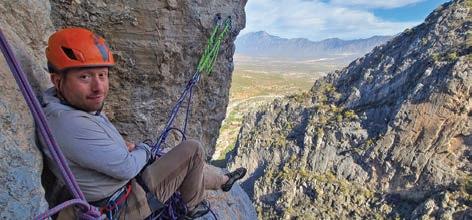
The art of the catch
Thankfully, over the course of the day, I get better at falling. By the end, I’ve taken a couple of four-meter falls and stuck the landings. It works to diminish my fear of falling, but the more valuable take-away turns out to be Alvero’s lesson on the subtle and under-appreciated art of the catch. We learn to be attentive and dynamic belayers, constantly managing the slack based on where the climber will land to put them in the safest place at the end of the ride. All the time he’d spent this morning talking about belaying was an investment in this result. Knowing that your belayer has learned the subtle art of the catch can be a calming tonic when you feel miles above your last piece and you’re pushing hard against your psychological boundaries.
By midweek, we find our routine. We wake shortly after sunrise to have breakfast in the communal kitchen — usually something in tortillas, like eggs scrambled with chorizo or vegetables, along with coffee, papaya, and avocado (always, everything with avocado). We chat about where each of us wants to climb, then the group disbands.
We climb in small groups until sundown every night, sometimes longer. A pair of powerful lamps splash light across the face of Wonder Wall until 10 or 11 at night so that we can climb without headlamps, but we usually wrap up at dark. Then we follow our noses, staggering into whichever food stand entices us. But by the end of the week, we’ve all agreed on which puesto has the best food and there is no need to coordinate our meetup location over the radio. The first group out just announces, “We’re down, we have a table,” because everyone knows we’re meeting at Crux.
On the last climbing day of the trip, we join the Yosemite Facelift Service Project. They have selected El Potrero Chico as their first international crag clean-up, and boy is it needed! The park is “well-loved” (i.e. abused) by many. Locals leave their picnic trash and beer bottles; climbers poop everywhere; wind plucks the trash out of the open 50-gallon drums and scatters it across the landscape. The spiny flora snags it, and the refuse spends the rest of eternity skewered like frog parts in the biology lab, a grotesque eyesore.

They give us mechanical grabbers and vinyl gloves, but most of the trash has been sterilized a thousand times over by the sun’s intense UV rays, so I don’t bother with either. The larger items like Styrofoam takeout trays and empty six packs are collected quickly. The rest of the morning, we are on our knees in the dry riverbed picking shards of glass and disintegrated bits of straws from the gravel. I am surprised at how satisfying it feels to unearth an intact bottle label with all the glass fragments still attached.
The wind is howling as we climb The Spires by moonlight on our last night. I smile to myself knowing that all the trash barrels below are empty. It’s been an exhausting, memorable, and at times magical trip. None of the worries or self-doubts that had nagged me during the weeks of organizing seemed to materialize. I planned and prepared enough. My Spanish was sufficient. We faced unpredictable complications, but no accidents. The two bags of first aid supplies I brought were barely touched all week. Nobody bickered, complained, or asked for more than I could accommodate. I leave Potrero wondering what I had been so afraid of.
On our final walk out of the park, we see the first and only scorpion of the trip, skittering alongside the road, crisscrossing through the rays of our headlamps. We take a photo for the group album and then leave it in the dark. He and I can face-off another day.

mountaineers.org 33
Clockwise from top left: Climber's Mural at Finca El Caminante. Photo by Dean Hunter. Sergey Frolov climbing Popsicle Kings. Photo by Kristin Haider. Steve McCarthy on Chico Spire by moonlight. Photo by Sergey Frolov. The Canyon at El Potrero Chico. Photo by Brian Degenhardt. Dean Hunter relaxing at the top of Will the Wolf Survive.
Photo by Sergey Frolov.
Naturalists of Yesterday, Today, and Tomorrow
Back in 1906, it took newly-minted Mountaineers 21 days to reach the top of Mt. Adams (known by Native peoples as Pahto), horse-travel time included. Popular peaks like Chimney Rock and Eldorado Peak had yet to be summited by Mountaineers members, and so few Washington residents could access the Olympic Mountains that they might as well have been on the other side of the country. The mountains, and the species that lived within them, were mostly a mystery to Western eyes.
The first Mountaineer Annual states that the goal of The Mountaineers was not only to “tell the… ascents of our high peaks” but to share “the results of our scientific studies.” Early Mountaineers were just as excited by species as they were summits, eager to document the wildlife while pursuing ascents. They wanted to know how the view looked from the top and on the way up: which trees adorned the hillsides, what critters hid amongst the understory, and how glaciers could change the face of a mountain. The ecological curiosity embedded in early outings show that Mountaineers were not only alpinists, but naturalists at heart.
While early Mountaineers naturalist activities showcase an ecologically-oriented motivation for recreation, it was imbued with Eurocentric understandings of the natural world that failed to understand and recognize the history and culture of Native peoples inhabiting these lands. This historical backdrop will always be a part of our founding story, one that we continue to grapple with as we work to recognize and repair harm. Today, we look back on our early ecological endeavors with a critical eye and strive to recreate respectfully and responsibly while honoring the role Pacific Northwest Indian tribes have played - and still play - in stewarding these lands. With a more contemporary and critical perspective, we can look at early recreationists' ecological interests as an inspiration to reinstill mindful ecological appreciation into our backcountry experiences.
Summits for science
For early Mountaineers, trip beta was not only recreational, but ecological. Scattered in-between summit reports and outing recollections of early Mountaineer Annuals are ecological field notes describing the specimens and geological phenomena encountered during outdoor excursions. Examples include an essay on “The Seed Plants, Ferns, and Fern Allies of the Higher Regions of the Olympic Mountains,” which boasts a list of over 360 species and was considered the first study of its kind; an

essay on “How to Know Trees,” which argues the importance of understanding a tree’s growth rate, soil preferences, and other life-habits; an essay on “The Whistling Marmot” and how the “flute-like cadence” of this “four-footed mountaineer” can easily be mistaken for a musician; and notes from the 1948 Juneau Ice Field Research Project, described as one of the “first major attempts to make any high level glacier studies in the North American continent.”
Annuals spanning from the 1930s to 1960s include notes on glacial recession and expansion in various peaks, a contribution to early conversations on glacial trends and climate impacts. As frequenters of the backcountry, Mountaineers were in high favor at the University of Washington for their ability to access and collect natural materials of interest. During World War II, Mountaineers worked in collaboration with UW and the Red Cross to collect sphagnum moss — which had long been used by Native peoples to treat wounds for infection — to send to the military in France for use as surgical dressings. And a special note of thanks can be found in the 1912 annual from Professor O. B. Johnson for the gift of beetle samples. “Few of us ‘beetle enthusiasts’ have facilities for going to those places that your club is organized for,” he writes, “so I repeat it is fortunate to have such an ally.”
Naturalists and conservation
The ecological musings included in Mountaineer Annuals
34 mountaineer | fall 2023 retrorewind
"White rhododendron or snow brush," from the 1910 annual.
were not only a means of documenting new discoveries but showcasing the biodiversity of the Pacific Northwest lands and waters to illustrate why these natural places deserved protection.
Over the years, our naturalist documentations gained significance as various parts of the state were under consideration for state and federal protection. During early conversations surrounding the creation of a Glacier Peak Wilderness Area, Mountaineers annuals bubbled with field notes demonstrating why the area was worthy of protection. A 1958 essay on the “Plant Life of the Area Surrounding Glacier Peak” describes the ecological and cultural significance of the area’s trees, arguing that “to see this great outdoor laboratory of natural science is to know immediately that it is well worthy of preservation.”

When the North Cascades was under consideration for National Park status, Mountaineers dedicated their 1964 summer outing to exploring and recounting the beauty of the region under the belief that “in view of the current efforts to make this area into a national park, as much of the area as possible should be seen by as many as possible.” The outing described flowers that were “rarely found as far south as British Columbia,” butterflies that had been “recorded only twice before in Washington,” as well as hummingbirds, goats, marmots, and bugs that beckoned federal protection.
Evolving naturalist methodology
As ecological knowledge advanced, so did our understanding of how to engage with the natural world with humility and respect. Early annuals note how Mountaineers could "easily handle female white-tailed Ptarmigans resting in their nests" or feed Gray Jays from outstretched hands. They also referenced attempts to enhance Washington’s natural environment by introducing invasive species so that Washington could resemble other alpine areas. The Edelweiss Committee was tasked with “securing seeds and plants of the Edelweiss from the Alps to further beautify the grand peaks of Washington,” and Alaskan plants “of surpassing beauty” were under particular consideration for introduction in our mountains. Although it’s hard to believe that city squirrels were once a prized symbol of beauty, Mountaineers were eager to help acquire these rodents to decorate urban parks, following examples from Wisconsin, Pennsylvania, and Virginia.
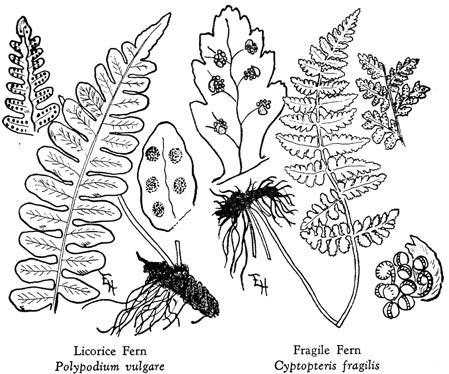

Now we understand the dangers of invasive species and feeding wildlife (“a fed animal is a dead animal”), reflected in the shifting of our teachings in recent decades. Today, we encourage members to enjoy the natural world with a perspective of humility and mindfulness, and to honor the places and wildlife Pacific Northwest Indian tribes have stewarded for thousands of years.
Naturalists today
While the reasons for exploring the backcountry have changed, the value of understanding its ecology remains. Lynn Graf and Stewart Hougen, co-chairs of Seattle’s Naturalist Committee, believe that ecology is still the “missing piece” in many outdoor trips. Their Intro to the Natural World course is an attempt to introduce folks to the biodiversity of the PNW and instill a love of the natural world among recreationists. The more recreationists know about the natural world, the more inclined they’ll be to appreciate and protect it.
“Our goals may not be that different from earlier times,” Lynn said. “We introduce those new to the PNW to the wonderful biodiversity here, from the intertidal zone to the alpine areas, and enrich the experience of more destination-oriented Mountaineers.”
mountaineers.org 35
"Heather," from the 1912 annual. Photo by C. R. Corey. "The cony or pika," from the 1921 annual. Photo by William L. and Irene Finley.
Illustrations of Glacier Peak flowers, from the 1958 annual.
Forget the Day, Seize Life!
By Craig Romano, Mountaineers Books Guidebook Author
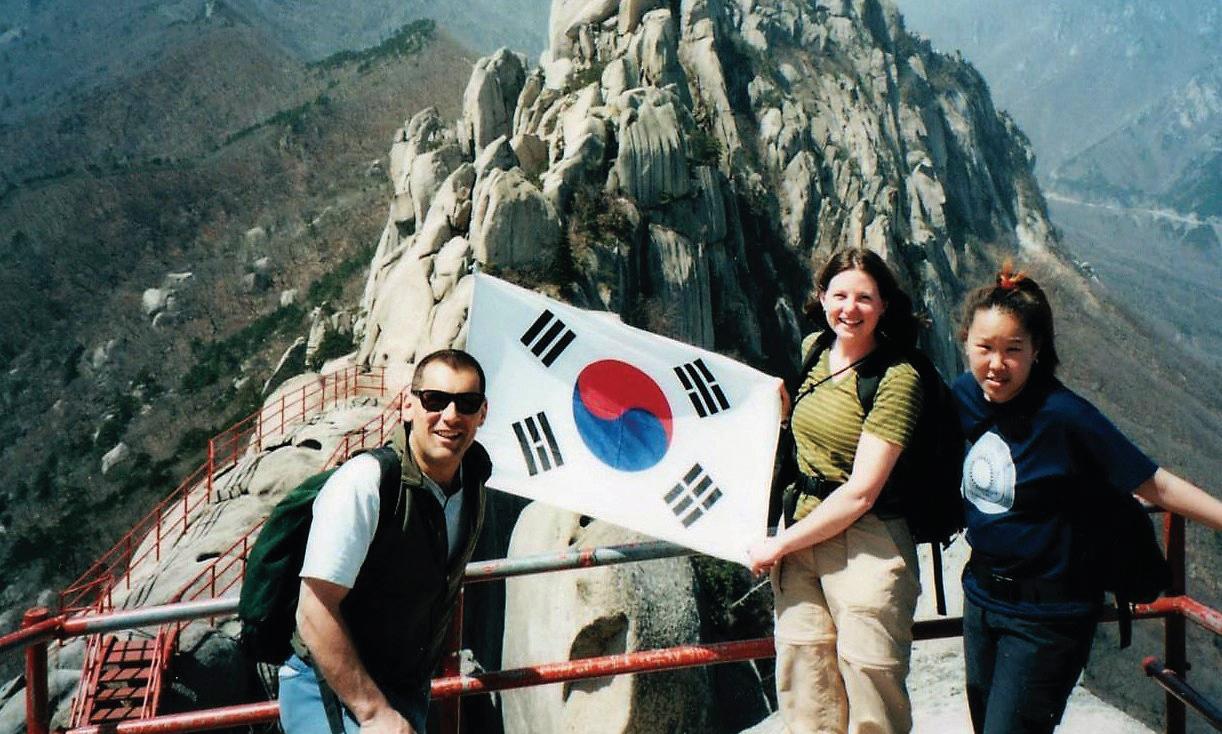
Ijust signed up for my first 100k trail run. Call it Existential Crisis Number — who knows, as I’ve had so many now, I’ve lost count! I was cursed at a young age knowing that there are so many things to experience in life, yet so little time to do them. This curse was also a blessing, as I’ve tried to live my life to the fullest, not wanting to waste a moment as moments are finite.
Like many creatives, I spend too much time wrestling with my inner thoughts. And like many creatives, I am prone to depression. Thankfully, I eschewed using harmful substances to deal with my depression decades ago — opting instead to binge on life experiences and get high on my own endorphins through physical activity. I let my wanderlust set my compass and embraced being an endurance junkie.
I’ve lived most of my life by projecting myself into the future and looking back. Is future me content knowing that he lived life to its fullest, or is he anguishing over blown opportunities and regretting not going for it when he had the chance? Now in my 60s, staring at the hour glass’s bottom half growing disproportionately larger, I see this perspective more valid than ever.
Life is too damn short. I’m taking every opportunity I can to seize the moment. Often, that means being open to things and experiences I’ve never considered.
Many of us are too rigid in our thinking and too restrictive in our lifestyles. We become set in our ways at a young age and embrace the safety of our comfort zones, which is rather ironic given how we’re taught that we have the whole world
at our fingertips. For those of us who venture beyond the comfortable, we often plot a path and timeline suitable to how we wish to navigate life. But life doesn’t work that way. And if we try to stay the course, we risk missing new experiences and exciting opportunities.
My most fulfilling experiences have been mostly unplanned. But a major one early in my life was part of a plan I embraced at age 14. I was intent on riding a bicycle around the country and at age 18, I did. Soon afterward, I seized the momentum with two more long distance rides. My combined bike rides were coming-of-age odysseys involving 14 months on the road through 49 states and 10 Canadian provinces. They were rife with situations eliciting the full range of emotions, and they exposed me to people from diverse backgrounds with diverse perspectives. That time on the road firmly established who I am today: someone who must keep moving, keep learning, and keep experiencing as many new places as possible.
Living life on my own terms also allowed me to embrace fleeting experiences, a difficult thing to do under traditional societal conventions. I learned to jump on opportunities that almost assuredly would not come again. Having friends in far flung places provided the perfect excuse to see new countries and cultures I hadn’t yet experienced. I knew, too, that my friends’ invitations were short-lived as their time in these places was transitory. It was either go now or not at all. So I went to South America for two months and spent 10 days floating down a major tributary of the Amazon. I hiked with a machete and ate food killed and cooked by Native guides. I caught dysentery and had a chigger infestation, and I was
36 mountaineer | fall 2023 trailtalk
Craig, his wife Heather, and their friend Jodi in Seoraksan Nationl Park, 1999. All photos courtesy of Craig Romano.
genuinely miserable in the stifling heat and humidity. But I am so glad I did it.
On that same trip I skied the Bolivian Andes on a glacier at 17,785 feet accessed by a primitive cable lift — the highest ski lift in the world. I was in pain, sucking oxygen while making a couple of turns, but it was exhilarating and unbelievable. The glacier is now gone, the skiing at Chacaltaya never to be done again, and I am so glad I took the opportunity to do it when I had the chance.
In the early years of my relationship with my now wife Heather, she was interested in working oversees. Me not as much. But when I went to a travel expo to inquire whether the owners of a tour company were hiring because my wife was interested — a funny twist in life occurred. The owners expressed interest in hiring me as well. So Heather and I ended up working together for five seasons in the Pyrenees of France and Spain, guiding Americans on hikes through some of the most stunning landscapes in Europe.
Afterward, I left a nascent teaching job (with all of its retirement benefits and a steady paycheck) in my 40s when I was given an opportunity to become a guidebook author for Mountaineers Books. They were looking for a new voice to
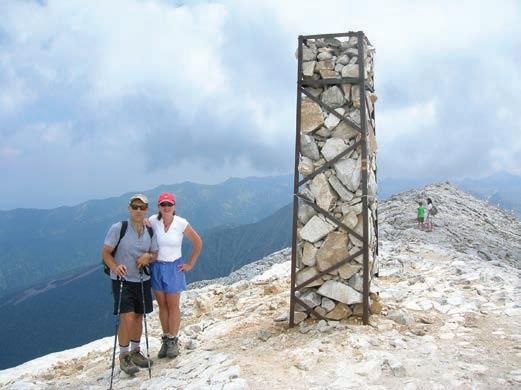

replace legendary guidebook pioneers Harvey Manning and Ira Spring. An opportunity like this only comes once. I not only seized it, I ran (and hiked) with it, penning books that allowed me to hike as many trails in as many wonderful places as I could. And I’m not through yet!

Which leads me to my first 100k. When I was approaching 50, I took up ultra-running. I had been running marathons since my late 20s, and I liked the appeal of running in the woods and pushing myself over challenging terrain and distances. I ran my first 50 mile run, the not-so-easy White River 50, to usher in my fiftieth birthday. Now 62, I’m going to attempt to run 62 miles. Sure, I could celebrate another year by sitting on a beach somewhere and drinking a beer. But that’s not how I prefer to live. Don’t get me wrong. I love beaches and I love beer. But I see turning 62 as another opportunity to get out of my comfort zone and try something new. So come October, I’m off to Southern California to run in the Cuyamaca 100k. What an opportunity, and I’m so glad I have it, for I have no idea how much longer I can take advantage of an opportunity like this — or any at all. Existential crises or not, I’m choosing to seize life. Will you?
Craig Romano is an award-winning guidebook author who has written more than 25 books, including Backpacking Washington, Day Hiking Central Cascades 2nd edition, and eight titles in the Urban Trails series (Mountaineers Books). Purchase his titles in our Seattle Program Center bookstore, online at mountaineersbooks.org, and everywhere books are sold.
mountaineers.org 37
Top left and above: Craig backpacking in Torres del Paine National Park in Chilean Patagonia, 1988. Left: Craig and Heather standing on Bulgaria's Vihren, the highest summit in the Pirin Mountains (9,560ft) and the second highest summit in the country, 2005.
Hiking Through History The Jordan Trail
By Charles Bookman, 23-year member
Toiling up a dry mountain shoulder in desert heat, I briefly question why I signed on to hike the highlights of Jordan’s national trail on a Mountaineers Global Adventures trip. Then I crest the shoulder of Jordan’s Grand Canyon and see the Dead Sea glimmering in the hot haze. I remember that this place has history. Jordan encompasses the biblical land of Moab. Nearby Mt. Nebo, above the Dead Sea, is where Moses saw the Promised Land. To the south, where we’re headed, lies Edom, fabled site of Sodom and Gomorrah. Visiting the desiccated salt flats around the Dead Sea, I can see these stories come to life.
Running north to south from Syria to Aqaba on the Red Sea, the unmarked Jordan Trail exists as GPS waypoints. A website provides maps and descriptions of the lightly-worn shepherd’s path and connects travelers with outfitters and guides. Greener in the north, where olive groves are common, the terrain dries out where Bedouins graze goat herds in the middle of the country. The trail crosses true desert as it reaches the famed ruins of Petra on its way to the extension of the Arabian desert known as Wadi Rum.
Trekking is new in Jordan. Our volunteer trip organizer worked with a Jordanian outfitter to plan the trip, making arrangements with Bedouin tribes to host us and to provide a guide from the local tribe who knew the route and the water sources. To help along the trail, the outfitter recruited Aboud Hijazi, an incredibly experienced traveler, group leader, and trailblazer for the new outdoor industry in modern Jordan.
Wadi Mujib, Jordan’s Grand Canyon

A great declivity known as Wadi Mujib runs from Jordan’s central highlands to the Dead Sea. To reach the canyon, we climb 3,000 feet up from Wadi Hidan and then drop down the other side into Wadi Mujib. A dirt track at the bottom reaches Bedouin encampments, where we camp.
The Bedouins set up tents for us and cook a fine meal of rice and lamb, which we enjoy under the stars. Our camp each night centers around a large Bedouin tent used for lounging and eating. We sleep in outlying small camp tents under heavy woolen blankets. The Bedouin communal tent is constructed of heavy woolen cloth erected on local stakes and tensioned

globaladventures 38 mountaineer | fall 2023
Our Bedouin guide and his donkey. All photos courtesy of Cheryl Talbert.
The Bedouin, who welcome us into their camps.
with thick cords. Meals are cooked over a fire, which the Bedouins light on a moment’s notice using the scant nearby brush. The men who made our camp make it clear that even though we are paying them, in their tradition we are their guests in every sense of the word.
As it is Ramadan, our hosts have not eaten all day. They wait for us to eat before breaking their fast with traditional Iftar (end of fast) dishes such as Labneh (aged goat yogurt) and dates. They share their Iftar with us as well.
Getting an early start the next morning, hoping to reach high ground before the heat of the day, we toil up almost 4,000 feet to a wide plateau covered with flowery meadows. We document over fifty species such as indigenous tulips and black iris.
From Dana to Petra
Over the next four days, we walk through the Dana Biosphere Reserve, Jordan’s largest natural area, and on to Petra, the fabled 2,000-year-old City of Tombs. Our trek from Dana to Petra passes through rugged mountains above Jordan’s great rift valley. Each day we climb 3,000-4,000 feet from dry, rocky valleys at the bottom to flowery meadows at higher elevations. We pass petroglyphs (rock carvings). Some are prehistoric while others are tens to hundreds of years old, maybe representing the creative efforts of idle shepherds. We look for dinosaur tracks that have recently been discovered. Walking up a dry creek bed through layers of sandstone, we soon find obvious fossil footprints of a small to medium-sized three-toed animal, a hundred-million-year-old carnivore called a theropod that once roamed the shoreline of an ancient sea.

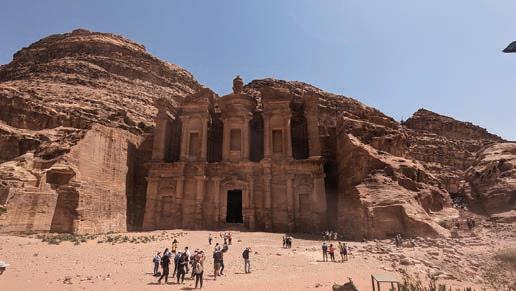

our hosts – their religion and culture requires great modesty around strangers. Throughout our journey, we see women skittering out of view or darting modestly into their tents.
With six days of hiking behind us, we shift gears, visiting the world heritage site of Petra and the spectacular desert known as Wadi Rum, snorkeling in the Red Sea, and bobbing 1,000 feet below sea level in the hypersaline Dead Sea. All of this — the trek in the desert, meeting and camping with Bedouins, and visiting the cities and sites of modern Jordan — was possible because of the efforts of volunteers organizing these activities through The Mountaineers. Rich with beauty, history, and hospitality, trekking the Jordan Trail is a trip I will never forget.
Global Adventures is The Mountaineers adventure travel program and currently offers a wide range of domestic and international activities suitable for all types of adventureseekers, such as trekking, backpacking, day hiking, and crosscountry skiing. We are currently seeking more trip leaders and planning new trips beyond the Pacific Northwest. Learn more and sign up at mountaineers.org/globaladventures.
After a particularly relentless and tedious descent, we seek the scant shade at the bottom. Following the wadi the last mile to our camping spot, we cross a rare running stream. We are all eager to take off our boots and put them in the cool stream. Sharing camp with the Bedouins helps us learn about their culture and life. Modern Bedouins own pickup trucks and cell phones, but they still follow the herds. Our guide is a good example of the old world blended with the new. When not guiding tourists, he works as a shepherd. He also attends college.
Bedouin women share in the work of tending the flocks, but we only catch brief glimpses of the women who live with

mountaineers.org 39
Hiking through the desert landscape of Wadi Rum.
A rare spring-fed stream providing relief to our desert-sore feet.
Wadi Mujib, Jordan's Grand Canyon, which runs from the Central Highlands to the Dead Sea.
Petra, City of the Dead.
go guide
Virtual Education Center and Calendar
Check out our Virtual Education Center and Calendar, your home base for accessing all of our great virtual learning tools. Find activities, events, and classes held online, and browse our educational resources for skills and more.
How to Get Involved
Step 1: Visit mountaineers.org/courses/virtual-education-center This is your first stop to find everything you need for outdoor education and exploration.

Step 2: Choose what you want to learn
There’s so much to explore! With a wide range of topics - from leadership tips to how to coil a rope - there’s something for everyone. We also have a special ‘Just for Fun’ section if you need a laugh.

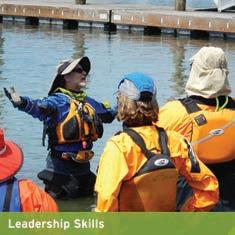


Step 3: Decide what kind of learning experience you want to have

Would you prefer to read a blog or complete an online course? What about attending a live webinar with an open discussion? We offer multiple educational formats to choose from so that everyone can find what works for them.
What You'll Find
18 Online Courses
200+ Educational Blogs
25 Virtual Events & Activities
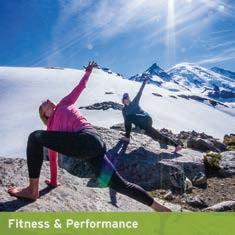
Step 1
Visit
Click
How to Sign Up for Activities
Step 2
Filter your activity search
Define your search using the filter options in the green column on the left. To view activities by location, choose ‘Map’ in the upper right.
Step 3
Select an activity & register
Click on the activity of your interest to learn more. If you like what you see, select the orange 'Register' button. You’ll be added to the trip roster and receive a confirmation email.
Note: Activities require registration unless otherwise noted. You will also need a current waiver on file with The Mountaineers to participate.
How to Sign Up for Events
Step 1
Visit our website
www.mountaineers.org
Click on the 'Upcoming Events' button on the left of the main page, or click 'More' and choose the 'Events' tab.
Frequently Asked Questions
Step 2
Browse for local events
Scroll down to view our most popular events, or choose a branch or program center calendar for more events in your area. Browse through your options, and click on an event to learn more.
Step 3
Select an event & register
Many events are free but require you to RSVP via the orange RSVP button. Events that require tickets will have a link for online ticket purchases.
What if I’m not a member? Many of our activities – especially day hikes and urban adventures – are open to the general public. You simply need to sign up for a guest membership at www.mountaineers.org/join. Guests can participate in two activities for free before joining.
What are some easy ways to get started? Sign up for an activity without prerequisites. These include day hikes, backpacking trips, stewardship activities, photography outings, and occasional sailing opportunities! Also, consider taking a basic or introductory course like Basic Snowshoeing, Introduction to Rock Climbing, Navigation, and much, much more! Visit www.mountaineers.org/courses to see what’s currently available.
How are events and activities different? Activities are primarily daylong outings that require participants to use skills in an outdoor setting. Examples include hikes, naturalist walks, or snowshoeing – in short, you are outside doing something. Events are open to the community, and are primarily opportunities to see presentations and socialize. Examples include summer picnics, branch banquets, and speaker series like BeWild, Walking the Wild, and the Adventure Speaker Series.
What if I don’t meet the prerequisites for an activity? Some of our technical activities, like climbing and kayaking, have prerequisite skill requirements. If you want to learn the prerequisite skills, we encourage you to take one of our courses. If you already have the prerequisite skills, you might qualify for equivalency. Email info@mountaineers.org and we will help you apply for equivalency so you can participate at the appropriate skill level.
Why do some activities say ‘Leader Permission Required’? All of our Mountaineers activities are led by volunteers. To ensure everyone on a trip has a set of specific skills, some volunteers require you to contact them in advance to participate. Before signing up for a trip that requires leader permission, please contact the leader by clicking on their name in the course/activity listing and send them an email. You can always email our Member Services team with questions at info@mountaineers.org.
What if the activity is full? Sign up for the waitlist! Yes, it works. We have roughly a 10-20% drop-out rate in courses and activities, so spots often become available.
mountaineers.org 41
our website
www.mountaineers.org
on the big green 'Find Activities' button, or hover over the ‘Activities’ tab and choose ‘Find Activities’.
Introductory Course Overview
Updated October 2022
The Mountaineers is a volunteer-led community built around sharing knowledge and skills to safely recreate outdoors. We offer courses every season and some all year round. The same course may be offered by multiple branches, and you can take a course with any branch. Exploring our clinics and seminars is also a great way to refine or expand your existing skills. Practice skills taught in our courses, learn about new techniques or gear, and explore new possibilities within our organization, like becoming an activity leader. Our clinics and seminars are often open to both our membership and the general public.
To learn when our courses are coming, take a look at our course calendar:
First Aid
Basic Wilderness Navigation
Avalanche AIARE Level 1
Conditioning Hiking Series
Backpacking and Wilderness Skills
Ski & Snowboard Mountaineering
Winter Camping
Basic Snowshoeing
Basic Wilderness Navigation
Frontcountry & Backcountry Trail Running
Fastpacking
Basic Alpine Climbing
Basic Alpine Scrambling
Rock Climbing: Learn to Belay & Intro to Rock
Cross Country and Skate Skiing
Canyoning
Basic Sea Kayaking
Sailing
Whitewater Packrafting
Basic Photography
Introduction to the Natural World
Outdoor Leadership Seminars
Basic Bikepacking
Flatwater Packrafting
Please visit www.mountaineers.org to see current course listings and to sign up. Course selection varies by branch. Registration usually opens 1-3 months prior to the start of the course.
42 mountaineer | fall 2023
ALPINE CLIMBING COU R S COURSEE B A S I BASICC ACKPACKING KPACKINC BACK ING PAC BACKPACKING COURSE CO U R SE AB S I C NATUR E P HOTOG R A P YH CO U R SE AB S I C NATUR E P HOTOG R A P YH COU RSE FIR S T AID D COU RSE FIRST AID
Open to Mountaineers members and the general public, our lodges provide visitors with unparalleled access to skiing, snowshoeing, hiking, and more. The Mountaineers is also home to the Kitsap Forest Theater, a historic outdoor theater showcasing two musical productions a year which are open to the public and a family favorite.
LODGE WEBPAGES Information about schedules, availability, meals, group rentals, and special events can all be found on the lodge webpages. You can also book your stay

Baker Lodge
mountaineers.org/bakerlodge
Mt. Baker Lodge, above Picture Lake and near Artist’s Point in the North Cascades, is a gorgeous place for a fall get-away with spectacular hikes walkable from the lodge, including the Chain Lakes Loop, Lake Ann, and Ptarmigan Ridge. Our committee is looking for help with maintenance work parties on the weekends of 9/9, 9/23, 10/14, and 10/21. Sign up and reserve your stay on the Baker Lodge website. The lodge will open for the winter season late November, with bookings opening in October.
Stevens Lodge
mountaineers.org/stevenslodge
Nestled near the Stevens Pass ski area, this rustic ski-in/ski-out lodge is open to PCT thru-hikers and mountain bikers in the fall, and skiers in the winter. Tired of the hustle and bustle of the big city? Come for a quiet respite to a cabin in the woods, with bunks for the whole family. Several trails are a short walk or drive from the lodge. The lodge is open Wednesday to Sunday during the winter when the ski area is open.

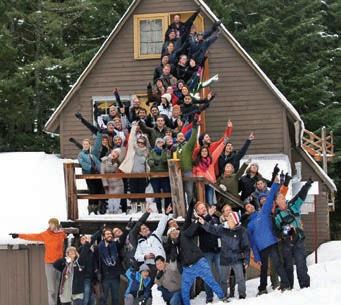
Meany Lodge
mountaineers.org/meanylodge
Come visit Meany Lodge this summer to enjoy our great food and hospitality. We're hosting work parties the last weekend of June, July, and August. Work parties also provide stewardship credit required for Mountaineer classes. Check our webpage for details and registration information. We’re looking forward to breaking bread with you!
online. To access our lodge webpages, visit the direct links listed below or go to mountaineers.org, click on ‘More’ in the top menu, and then click on ‘Locations & Lodges’ in the dropdown menu.
VOLUNTEER Our lodges and the Kitsap Forest Theater are run by dedicated volunteers, and they can use your help! Visit their webpages to learn how you can contribute to the teams that keep our outdoor centers running.

Kitsap Forest Theater
foresttheater.com
Theater inspired by a magical place! Stroll down the forested trail to our breathtaking theater and create a treasured family tradition. Our 2024 shows are enchanting musicals perfect for all ages – treat yourself to a day away in the forest. Matilda, the Musical is the inspiring story of a special girl with an extraordinary imagination who dreams of a better life and changes her destiny. Cinderella, The Broadway Version, is a new take on a classic story with a hilarious libretto, surprising twists, and the unforgettable score from Rodgers & Hammerstein.
We’re looking for cooks for rehearsal and performance weekends. We also need help with property upkeep and set building, costume sewing, ushering, and parking during shows.
We offer an Adventure Camp for grades K-4 and a Theater Camp for grades 5-8.
outdoorcenters
Baker Lodge
Stevens Lodge
mountaineers.org 43
Meany Lodge
branchingout
The Mountaineers is home to seven branches, each offering a number of courses and seminars. Our branches also host a variety of events like picnics, film screenings, and guest speakers. Regardless of which branch you join, you can sign up for offerings with any branch. Learn more at mountaineers.org/locations-lodges.
BELLINGHAM
Chair: Nathan Andrus, nathan.andrus@gmail.com
Website: mountaineers.org/bellingham; bellinghammountaineers.com
COURSES & ACTIVITIES: avalanche safety, navigation, climbing, first aid, hiking, scrambling, stewardship and conservation.
You’ll find the Bellingham Branch tucked alongside the upper craggy expanse of the North Cascades. We enjoy easy access to the peaks that drain into the Nooksack and Skagit River basins. Our close-knit community offers climbing courses, hiking trips, and backcountry adventures in a diverse, inclusive, and supportive environment. We’re also home to one of the most popular Mountaineers getaway destinations, Mt. Baker Lodge.
Branch Council meetings are on the fourth Tuesday of each month. Visit our branch calendar for details.
EVERETT
Chair: Nick Mayo, nicholas.e.mayo@gmail.com
Website: mountaineers.org/everett
COURSES & ACTIVITIES: avalanche safety, backcountry skiing, climbing, cross-country skiing, first aid, hiking & backpacking, navigation, scrambling, sea kayaking, snowshoeing, and stewardship.
Founded in 1911, the Everett Branch offers several programs. As a smaller branch, we value companionship and are excited to restart inperson events including our Salmon Bake, Gear Grab & Potluck, Annual Awards Banquet, and more. Check our branch calendar for details. Our branch is also known for our unique Lookout and Trail Maintenance Committee, which restored the Mt. Pilchuck Lookout and continues to maintain the historic Three Fingers Lookout. Branch Council Meetings are held every other month to discuss new and ongoing initiatives and are open to all. We host a combination of hybrid and fully remote meetings depending on the month. As we ramp up our in-person events and programs, we are looking for talented and passionate volunteers to make an impact. Please reach out to Nick Mayo (email above) for details.
KITSAP
Chair: John Mackey, john@pttaxcpa.com
Website: mountaineers.org/kitsap
COURSES & ACTIVITIES: climbing, exploring nature, first aid, hiking & backpacking, navigation, outdoor leadership, scrambling, sea
kayaking, snowshoeing, and youth & family. The Kitsap Branch draws members from throughout western Puget Sound, from Gig Harbor to the Olympic Peninsula, including Pierce, Kitsap, Jefferson, and Clallam counties. Join us at our program center, conveniently located in Bremerton.
Branch Council Meetings are held in February, May, August, and November. Our annual branch celebration is in October, please join us! Visit our branch calendar for details.
SEATTLE
Chair: Tess Wendel, tesswendel@gmail.com
Website: mountaineers.org/seattle
COURSES & ACTIVITIES: avalanche safety, canyoning, climbing, cross-country skiing, exploring nature, first aid, folk dancing, hiking & backpacking, navigation, outdoor leadership, photography, retired rovers, sailing, scrambling, sea kayaking, snowshoeing, stewardship, and urban walking.
The Seattle Branch began as the sole club location in 1906 when The Mountaineers was founded. Our Meet The Mountaineers open houses are held about once a month and are a great way for new and prospective members to learn about our many offerings. Our branch is also home to the Seattle Program Center, which features a book store, indoor and outdoor climbing walls, event spaces, and more. Branch Council meetings are held every other month to discuss new and ongoing initiatives. We’re growing rapidly and actively seeking people to support our community. Visit our branch calendar for details and reach out to the branch chair if you are interested in volunteering.
FOOTHILLS
(I-90/I-405 CORRIDORS)
Chair: Brad Peacock, bmpeacock@aol.com
Website: mountaineers.org/foothills
COURSES & ACTIVITIES: AIARE avalanche safety, backcountry and downhill skiing, climbing, conservation and stewardship, crosscountry skiing, first aid, hiking & backpacking, navigation, scrambling, snowshoeing, urban walking, and trail running.
The Foothills Branch is the club’s newest branch, founded in 2004 and encompassing the eastside communities along the I-90 and I-405 corridors. In addition to our educational and activity programs, we host film screenings, guest speakers, and stewardship events with the Mountains to Sound Greenway Trust,
Shadow Lake Nature Preserve, WTA, and other conservation-minded partners. We are also excited to be a close partner with Meany Lodge! Our branch is growing rapidly, and we are actively seeking people to support our community – no prior experience required. We invite you to get involved in branch leadership and committees to get our communities outside. Contact the branch chair if you might be interested.
Branch Council Meetings are held every other month (except summer) to discuss new and ongoing initiatives. All branch members are welcome! Visit our branch calendar for details.
TACOMA
Chair: Curtis Stock curtis@tacomamountaineers.org
Website: mountaineers.org/tacoma
COURSES & ACTIVITIES: avalanche safety, climbing, first aid, hiking & backpacking, navigation, outdoor leadership, photography, sailing, scrambling, sea kayaking, snowshoeing, and youth & family.
The second largest of all seven branches, the Tacoma branch maintains its own program center in the Old Town neighborhood of Tacoma, as well as the Irish Cabin property located near Mt. Rainier. A great way get involved is our Meet the Tacoma Mountaineers event, consisting of a meet-and-greet and a 90-minute interactive presentation giving you opportunities to learn about our history, our website, and how you can get involved.
Branch Council meetings are held every six weeks to discuss new and ongoing initiatives and general branch business. Visit our branch calendar for details.
OLYMPIA
Chair: Janette Zumbo, janettezumbo@gmail.com
Website: mountaineers.org/olympia
COURSES & ACTIVITIES: avalanche safety, backcountry skiing, climbing, cross-country skiing, exploring nature, first aid, hiking & backpacking, navigation, outdoor leadership, scrambling, sea kayaking, stewardship, snowshoeing, wilderness skills, and youth & family. Our branch is known for its robust stewardship program.
Our Adventure Speaker Series ends its season in March. Visit our website for details. Branch Council Meetings are held at 6pm on the second Wednesday of the month, alternating in-person and Zoom, though Zoom is always available. Members are encouraged to attend. Contact Janette Zumbo for information about attending.
BELLINGHAM EVERETT SEATTLE FOOTHILLS TACOMA OLYMPIA KITSAP 44 mountaineer | fall 2023
Board and Branch Elections
September 1-22, 2023
Each year we host elections for our Board of Directors and participating branches. This year, we are voting on five Board candidates. Candidates are selected by the Governance Committee from members who submit a self-nomination form, and then endorsed by our Board of Directors. Our Foothills and Olympia Branch members can also vote for their Branch leadership this year.
Voting is open September 1–22, 2023. Check your inbox September 1 for your ballot. If you don't see an email from us, you can submit a paper ballot or vote online at www.mountaineers.org/blog/board-branch-elections-2023.
Results will be announced October 1, 2023.
Join us virtually for The Mountaineers Annual Meeting on October 25 to learn more about our new strategic plan. RSVP at www.mountaineers.org/AnnualMeeting2023.
membershipmatters
EXPLORE
member benefits
As a Mountaineers member you have access to:
Courses, clinics, and seminars to gain lifelong skills
Activities to get outside and find community

Gear Library access to help outfit your trips
Lodge access at our Baker, Meany, and Stevens lodges
20% off Mountaineers Books publications and Green Trails maps
10-70% off gear and experiences from our partners
And more!
To learn more, visit mountaineers.org/membership/benefits
Photo by Ronald Jones.
The Fall Equinox and its Celestial Phenomena
By Skye Michel, Associate Communications Manager
The shift away from summer’s longer, warmer days typically comes with apprehension. Even the snowsport fanatics brace themselves for the oncoming gloom of fall and winter days. But this new season has a lot to offer, especially if we keep our heads up and our eyes toward the sky. Thanks to the fall equinox, there are some neat things to watch out for this month.
What is an equinox?
An equinox happens twice a year: on the first day of fall and the first day of spring. Most of us recognize the equinox as a full day, but it’s actually the exact moment in time when the sun passes over the celestial equator. During the fall equinox, the sun passes the equator toward the south, resulting in gradually shorter days for the northern hemisphere as the North Pole starts tilting away from the sun. Because of the sun’s position over the equator during the equinox, both day and night are equal in length. Prepare your countdown — this year’s fall equinox will occur September 22 at 11:49pm.
The Harvest Moon
Prior to modern technology, farmers used celestial phenomena to track the changing seasons and govern farming practices. One of the most significant markers used by farmers was the moon. Moon phases indicated when to plant, weed, build fences, castrate animals, go fishing, and even gather the most flavorful horseradish. Each month’s moon had a specific nickname for the particular phenomena occurring during that period, such as the February Snow Moon for its heavy amount of snowfall, or the October Hunter’s Moon for its fattened game.
One of the most important moons was the Harvest Moon, the first full moon following the fall equinox. The Harvest Moon was a distinct symbol of the changing seasons, indicating the onset
of shorter days and colder months, named for the role it played in aiding farmers during the end-of-summer harvest.
Each night, the moon rises about an hour later than the previous night’s moonrise, but because of the tilt of the earth and the angle of the moon’s orbit during the fall equinox, the moon only rises about 10-30 minutes later (depending on latitude) for a few nights in a row. The additional post-sunset light provided by the Harvest Moon allowed farmers to work into the night and finish up their harvesting of summer crops before turning in for the winter. Nowadays our evening obligations aren’t as dependent on the moon, but we can still appreciate the glow of the Harvest Moon as we brace for longer nights.
Brighter aurora borealis

The fall equinox is not only great for appreciating the earth’s bounty, but the sky’s. During the fall equinox, people in the northern hemisphere are set to witness peak viewings of the Northern Lights. This is because the sun experiences a much higher rate of geomagnetic electrical disturbance (aka it’s shooting out a bunch of stuff). At the same time, the earth is tilted such that the North and South Poles sit perpendicular to the sun’s solar winds, increasing the chances that these solar wind particles enter our atmosphere and cause the aurora borealis glow. The combination of the sun’s heightened activity and the earth’s tilt are what enhance our chances of seeing the incredible light show this month.
Seize the shifting season
Whether fall means new adventures or waiting nine more months for summer, take advantage of the fall equinox and its celestial events. From big moons to glowing, green skies, this season offers plentiful bounty to appreciate.
didyouknow
46 mountaineer | fall 2023
Photo by Zach Goldberg.

For 50 years, Hilleberg has been making the highest quality tents and shelters available. Developed in Sweden, manufactured in Europe, and used worldwide, Hilleberg tents and shelters offer the ideal balance of high strength, low weight, ease of use, and comfort. hilleberg.com 1-866-848-8368 order a Free catalog: Facebook.com/HillebergTheTentmaker 1971 2021 ce le br at in g years Jon Dykes/Hilleberg Team Staying local doesn’t mean settling for less! Take your Hilleberg tent and get out there. Staying local doesn’t mean settling for less! Take your Hilleberg tent and get out there.
The Mountaineers 2023/2024
Leadership Conference
The Leadership Conference is back! For the first time ever, the conference will be held in both Seattle and Tacoma. Join us for two days of professional development dedicated to thanking, inspiring, and empowering The Mountaineers current and aspiring volunteer leaders.
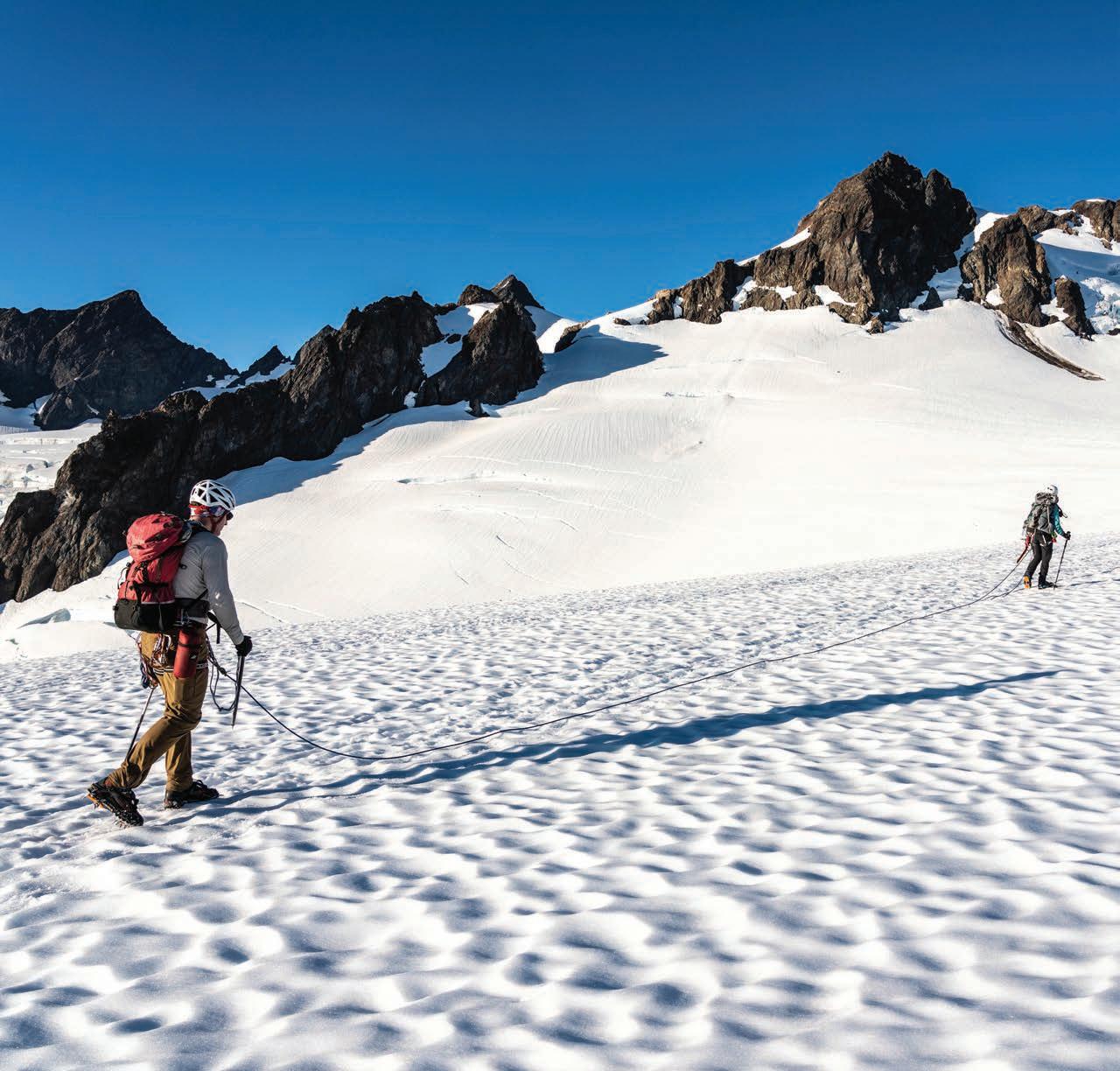
SAVE THE DATE!
Seattle Leadership Conference
Saturday, December 2, 2023
8:30am-4pm at the Seattle Program Center
Tacoma Leadership Conference
Saturday, March 23, 2024
8:30am-4pm at the Tacoma Program Center
Photo by Nate Brown.









 Skye Michel skyem@mountaineers.org
Photo by Eleanor Lewis.
Skye Michel skyem@mountaineers.org
Photo by Eleanor Lewis.








 By Roger L. Di Silvestro
By Roger L. Di Silvestro

 By Renny Jackson and Leigh Ortenburger
By Renny Jackson and Leigh Ortenburger









 By Michelle Song, Volunteer Development Manager
By Michelle Song, Volunteer Development Manager

 - Conor Marshall, Advocacy & Engagement Manager
- Conor Marshall, Advocacy & Engagement Manager
















 This is the Snow Lake poop hole. Can’t complain about that view. 11/10. Photo by Sharon Barnard.
This commode overlooks Boston Basin. It even has a plastic seat. And sunset views. 14/10.
Photo by Eli Mauksch.
This super pooper is big enough for two. Poop with friends! 12/10. Photo by Melinda Harris.
Peak a poo! This loo comes with a view of Desolation Peak. Extra drum for overflow storage. 13/10.
Photo by Monica Price.
This is a true alpine throne. Few views are privier. If Eldorado wasn’t on your list before, it is now. 14/10.
Photo by Brandon Hoxie.
Lookout for splinters at this Hidden Lake thunder bucket. What a place to breathe in the fresh mountain air. 11/10. Photo by Olga Toropova.
This Red Top Lookout privy has a door, walls, and sloughs snow like a boss. At least the door is a little broken, so you’ll never be truly alone. 12/10.
Photo by Alana Miller.
This enchanting hole gazes longingly at Prussik Peak. You’ll want to stay a while. 13/10.
Photo by Angela Argyropoulos.
The hills are alive with the views from the Tyee Lookout potty box. Clouds, grass, and trees? Yes please! 12/10.
This is the Snow Lake poop hole. Can’t complain about that view. 11/10. Photo by Sharon Barnard.
This commode overlooks Boston Basin. It even has a plastic seat. And sunset views. 14/10.
Photo by Eli Mauksch.
This super pooper is big enough for two. Poop with friends! 12/10. Photo by Melinda Harris.
Peak a poo! This loo comes with a view of Desolation Peak. Extra drum for overflow storage. 13/10.
Photo by Monica Price.
This is a true alpine throne. Few views are privier. If Eldorado wasn’t on your list before, it is now. 14/10.
Photo by Brandon Hoxie.
Lookout for splinters at this Hidden Lake thunder bucket. What a place to breathe in the fresh mountain air. 11/10. Photo by Olga Toropova.
This Red Top Lookout privy has a door, walls, and sloughs snow like a boss. At least the door is a little broken, so you’ll never be truly alone. 12/10.
Photo by Alana Miller.
This enchanting hole gazes longingly at Prussik Peak. You’ll want to stay a while. 13/10.
Photo by Angela Argyropoulos.
The hills are alive with the views from the Tyee Lookout potty box. Clouds, grass, and trees? Yes please! 12/10.

 This camouflaged commode hides in Hannegan Pass. It comes with wildflowers galore and views for days. 14/10. Photo by Brooke Kisser.
This camouflaged commode hides in Hannegan Pass. It comes with wildflowers galore and views for days. 14/10. Photo by Brooke Kisser.
 By Christine Leibbrand, four-year member
By Christine Leibbrand, four-year member





 Photo by Skye Stoury.
Christine and Andrew hiking in Iceland. Photo by Andrew Lapinsky.
Christine running in the Seattle Rock and Roll Marathon in 2017.
Photo by Skye Stoury.
Christine and Andrew hiking in Iceland. Photo by Andrew Lapinsky.
Christine running in the Seattle Rock and Roll Marathon in 2017.







































